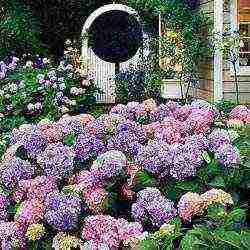Content
- 0.1 Bearded irises
- 0.2 I. attica (I. attic)
- 0.3 I. lutescens (synonym I. chamaeirls) (I. yellowish)
- 0.4 l. pumila (I. dwarf)
- 0.5 Aphylla (I. leafless)
- 0.6 "Bibury"
- 0.7 "Blue Pools"
- 0.8 "Jeremy Brian"
- 0.9 "Kentucky Bluegrass"
- 0.10 "Melon Honey"
- 0.11 "Sara Taylor"
- 0.12 J. florentina (I. florentine)
- 0.13 I. germanica (I. german, Kasatik)
- 0.14 "Bronzaire"
- 0.15 "Curlew"
- 0.16 "Honey Glazed"
- 0.17 "Maui Moonlight"
- 0.18 "Miss Carla"
- 0.19 "Rare Edition"
- 0.20 "Raspberry Blush"
- 0.21 I. pallida ssp. cengialtii (I. pale)
- 0.22 I. pallida (I. pale)
- 0.23 "Argentea Variegata"
- 0.24 "Aurea Variegata"
- 0.25 Рallida ssp. pallida (synonym J. pallida var.dalmatica) (I. pale variety Dalmatian)
- 0.26 "Blue Rhythm"
- 0.27 "Sun Dappled"
- 0.28 "Champagne Elegance"
- 0.29 "Gay Parasol"
- 0.30 "Mystique"
- 0.31 "Pasco"
- 0.32 "Warleggan"
- 0.33 "Edith Wolford"
- 1 Beardless irises
- 1.1 I. douglasiana (I. Douglas)
- 1.2 I. innaminata (I. unnamed)
- 1.3 Banbury Beauty
- 1.4 Banbury Melody
- 1.5 Broadleigh Carolyn
- 1.6 "No-name"
- 1.7 "Lavendar Royal"
- 1.8 I. fulva (I. brown-yellow)
- 1.9 I. fulvala (hybrid of I. brown-yellow and I. short-stemmed)
- 1.10 I. ensata (synonym J. kaempferi) (I. xiphoid, I. Kampfer)
- 1.11 "Variegata"
- 1.12 "Rose Queen"
- 1.13 I. laevigata (I. smooth)
- 1.14 I. pseudacorus (I. false, I. swamp)
- 1.15 "Variegata"
- 1.16 Holden Clough
- 1.17 I. versicolor (I. multicolored)
- 1.18 I. virginka (I. virginsky)
- 1.19 Gerald Darby
- 1.20 I. sanguinea (I. blood red)
- 1.21 I. sibirica (I. siberian)
- 1.22 "Anniversary"
- 1.23 "Butter Sugar"
- 1.24 "Cambridge"
- 1.25 "Dreaming Yellow"
- 1.26 "Limeheart"
- 1.27 Orville Fay
- 1.28 "Ruffled Velvet"
- 1.29 "Shirley Pope"
- 1.30 "Silver Edge"
- 1.31 "Soft Blue"
- 1.32 "White Swirl"
- 1.33 "Wisley White"
- 1.34 I. chrysographes (I. golden-painted)
- 1.35 I. forrestii (I. Forrest)
- 1.36 Spuria irises (Spuriae)
- 1.37 I. graminea (I. cereal)
- 1.38 I. kerneriana (I. Kerner)
- 1.39 I. orientalis (synonym I. ochroleuca) (I. oriental)
- 1.40 Shelford Giant
- 1.41 I. spuria (I. false)
- 1.42 "Adobe Sunset"
- 1.43 L. foetidissima (I. stinky)
- 1.44 J. f. ritrina
- 1.45 I. setosa (I. bristly)
- 1.46 I. unguicularis (I. marigold)
- 2 Comb irises
- 3 Growing
- 4 Reproduction
- 5 Pests and diseases
- 6 Bulbous and rhizome varieties of irises: photo and description of flowers
- 7 Photos and names of iris varieties, conditions for growing and caring for flowers in the open field
- 8 What do bearded irises look like?
- 9 How to care for irises: planting and caring for bulbous and rhizome flowers
- 10 Diagram of how to properly plant and transplant irises
- 11 How to grow irises: fertilizing and preparing for winter
- 12 Treatment of diseases and methods of pest control of irises (with photo)
- 13 We buy planting material
- 14 Choosing a place for planting bearded irises
- 15 We select the soil for planting bearded irises
- 16 We plant irises correctly
- 17 Solving the question of the planting pattern of bearded irises
- 18 German iris
- 19 Bearded irises: description
- 20 Iris Germanic: varieties
- 21 Sultan's Palace
- 22 English Cottage
- 23 Crinoline
- 24 Iris Germanic: planting and care
- 25 We process the planting material
- 26 Landing in the ground
- 27 Iris care
- 28 Some more tips
In the flowers of the iris, named after the Greek goddess of the rainbow Iris, the sophistication of the architectural form is combined with a huge variety of bright and delicate color tones. Their beauty has been famous since ancient times.
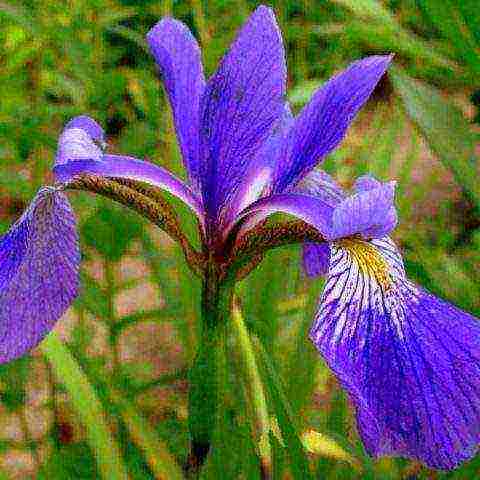 Iris
Iris
Irises are valued for the beautiful shape of the flowers, as well as the richness and variety of their colors. They make up a very large genus, consisting of about 300 species of a variety of plants - from tiny rocky to giant aquatic irises. Their varieties are suitable for growing in many areas of the garden, especially along the banks of ponds, on curbs and in rockeries. The flowering season ranges from early spring to mid-summer. There are varieties with repeated flowering. In warm climates, you can pick up varieties and types of irises so that they bloom for nine months!
Under the right conditions, irises are easy to grow, durable and only require periodic division.
In a typical iris, flower parts are grouped in three. The three inner tepals are called standards. They are usually vertical and serve to attract pollinators. The three outer tepals are called fouls. Fouls form a landing area for insects, they are drooping or horizontal. In the center of the flower, three large stigma lobes are visible, which can create an additional decorative effect.
This group includes plants with either fleshy aerial creeping rhizomes or thinner underground rhizomes.Depending on the structure of the flower, they are divided into three groups: bearded irises (there is a beard of hairs in the center of the fouls), beardless irises (there are no hairs on the fouls, but there is often a pattern of comte and irises, known as comb, or Evansia (with a fleshy crest on fouls).
Bearded irises
All bearded irises prefer neutral to slightly alkaline soil. Among them, two groups are clearly distinguished: the Aryl and Arilbredov group (Arillate Group) and the bearded irises proper - the Eupogon Group. The Arillate group is called so because the seeds of these irises have fleshy outgrowths attached to them - aryllus. These plants come from deserts and are very difficult to grow. They need warm and dry conditions, plenty of light and frost-free winters. The irises from the Eupogon group do not have arillus. These include the most lush irises that bloom in spring and early summer. All of them are winter-hardy to one degree or another, they are easy to grow in a sunny place and subject to good drainage.
Irises can be bulbous or rhizome. Rhizome irises are divided into three large groups: bearded, beardless and comb. Bearded irises, in turn, are subdivided into miniature dwarf (Miniature Dwarf Bearded, MDB), standard dwarf (Standard Dwarf Bearded, SDB), medium-sized (Intermediate Bearded, IB), border (Border Bearded, BB), miniature tall (Miniature Tall Bearded, MTB) and high (Tall Bearded, TV). Beardless irises are divided into Siberian (Sibiricae), Californian (Californicae), water-loving (Laevigatae), spuria irises (Spuriae), Louisiana (Hexapogonae) and little-known (Miscellaneous). Bulbous irises are divided into three groups: Reticulata, Juno and Xiphium.
The xiphoid leaves of most irises are gray-green, fan-shaped to the top of the rhizome. Peduncles rise from the center of the fan. At the end of flowering, the leaves on the peduncles die off.
The flowering season of bearded irises depends on their height: undersized plants bloom earlier than taller ones. Bearded irises are divided into six groups depending on the height and flowering time.
- Miniature dwarf bearded (MDB)
These irises are less than 20 cm tall. Flowers form from April to late May, usually 5-7.5 cm in diameter. All plants are winter-hardy, but most prefer a sunny location with well-drained soil in a rocky garden or in a well-ventilated unheated greenhouse.
I. attica (I. attic)
The plant forms yellow flowers with a green tint; it is not hardy enough in cold, wet winters. Homeland -Greece and Turkey. Height - 5-10 cm.
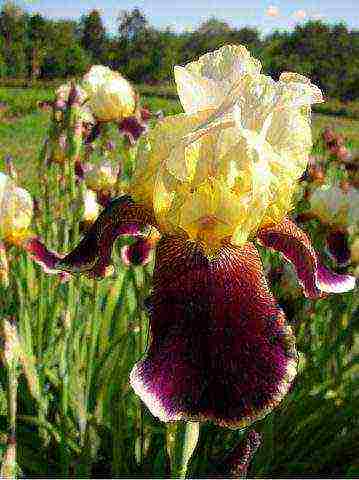 Yellow flowers
Yellow flowers
I. lutescens (synonym I. chamaeirls) (I. yellowish)
Flowers up to 10 cm wide, white, purple or yellow. Homeland - Yu.-V. France and S.-Ya. Italy. Height - 15-25 cm.
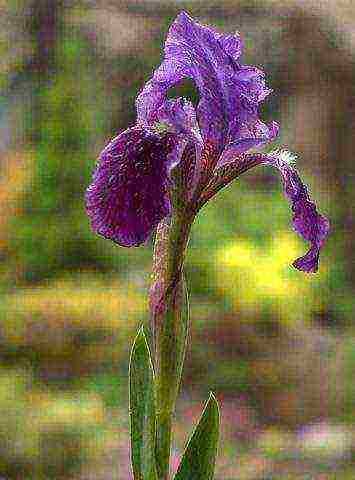 I. lutescens
I. lutescens
l. pumila (I. dwarf)
The earliest bearded iris that blooms in mid-spring. Flowers up to 7.5 cm in diameter, with bent down fouls, are white, in yellow and purple tones, or yellow with an admixture of brown. Most forms with very short stems, the height of the plant is the flower itself. The plant grows best on an alpine slide. One of the most reliable types of this group. Homeland - Russia, Yu.-V. Europe. Height-up to 10 cm.
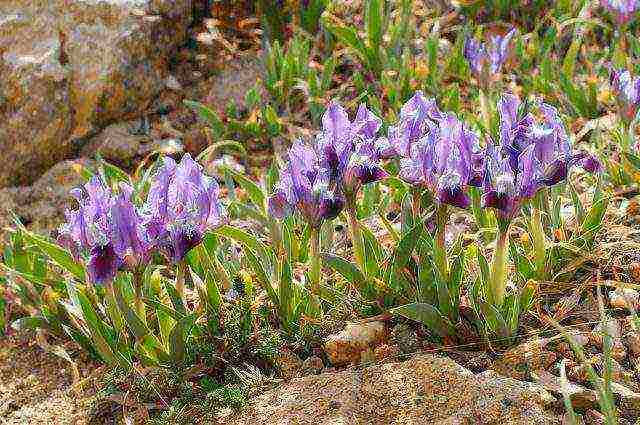 l. pumila
l. pumila
- Standard dwarf bearded (SDB)
These irises bloom at the end of May, their height is 20-38 cm. Flowers are up to 10 cm in diameter. They are all hardy and great for curbs or rocky gardens.
Aphylla (I. leafless)
Each branched stem bears 3-5 blue-violet flowers with a white or bluish beard. Occasionally it blooms again in autumn. The name was given because in the second half of summer the plant completely loses its leaves. Homeland - the south of Russia, Ukraine and Turkey. Height -15-45 cm, but usually 30-38 cm.
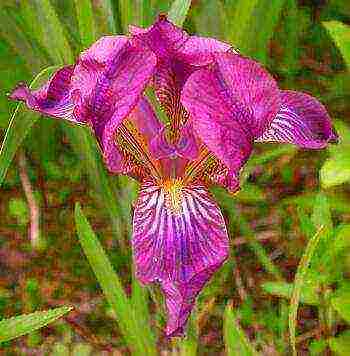 Aphylla
Aphylla
Long-term hybridization between I. aphylla and I. lutescetis led to the appearance of fragrant flowers on branched stems, which often bloom again.
The numerous hybrids of standard dwarf bearded irises include the following varieties.
"Bibury"
A variety with creamy white flowers and blue beards. Reaches 30 cm in height.
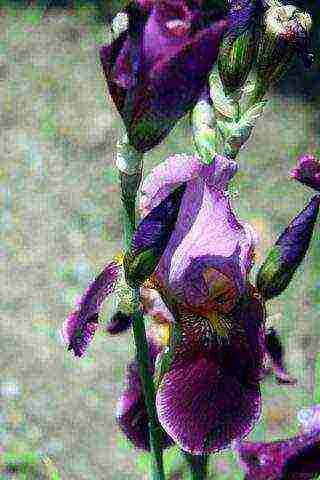 "Bibury"
"Bibury"
"Blue Pools"
The flowers are white with a dark blue spot and a bluish-white beard. The plant grows up to 25 cm.
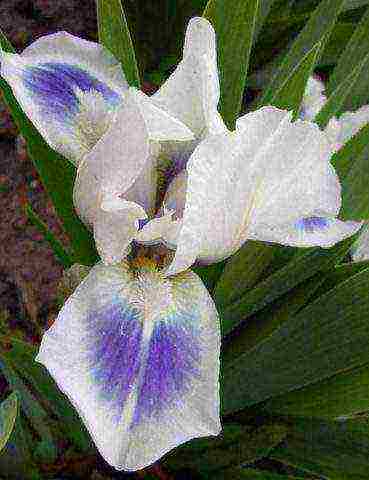 The flowers are white with a dark blue spot
The flowers are white with a dark blue spot
"Jeremy Brian"
The variety has light blue flowers with a white sheen and a creamy beard, grows up to 25 cm.
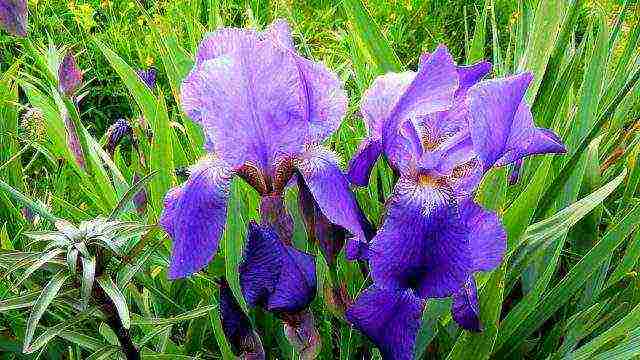 "Jeremy Brian"
"Jeremy Brian"
"Kentucky Bluegrass"
In the coloring of flowers, the cream color is combined with the color of lime green, the beard is dark blue. The variety is up to 36 cm tall.
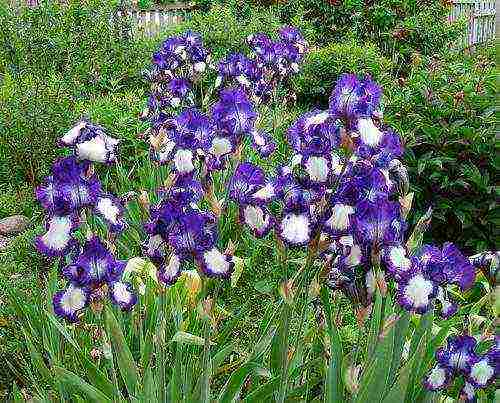 "Kentucky Bluegrass"
"Kentucky Bluegrass"
"Melon Honey"
Melon flowers are light orange with a creamy beard. The plant grows up to 30 cm.
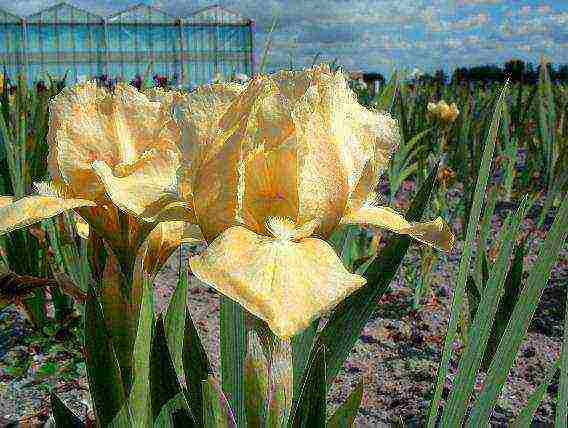 Melon flowers, light orange
Melon flowers, light orange
"Sara Taylor"
Lemon yellow flowers with a blue beard. Height-up to 30 cm.
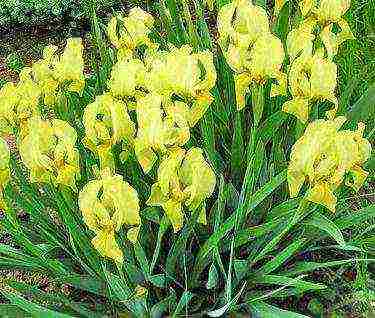 Lemon yellow flowers
Lemon yellow flowers
- Medium bearded (IB)
Medium-sized bearded irises bloom from late May to early June and form flowers up to 10 cm in diameter. Plants grow up to 40-70 cm in height. They occurred mainly as a result of crossing dwarf bearded irises with tall bearded irises.
J. florentina (I. florentine)
The flowers are white with a bluish tinge, they are formed in 4-5 on a strongly branched stem. This iris adorns the coat of arms of Florence. It is widely grown in the fields for the perfume industry. This species does not overwinter in central Russia. Homeland -Ts. Italy. Height - 45 cm.
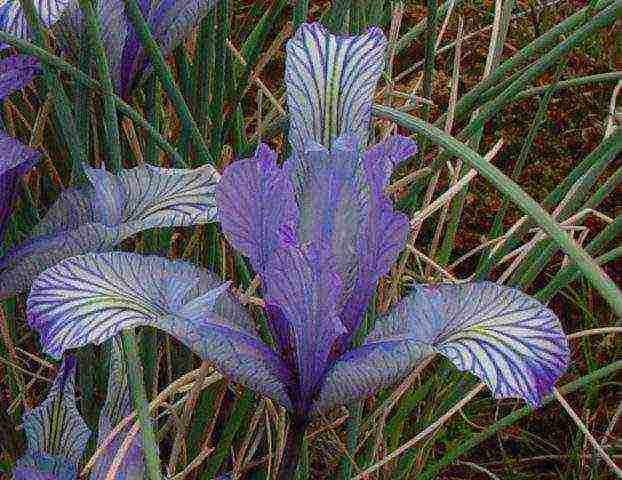 The flowers are white with a bluish tinge
The flowers are white with a bluish tinge
I. germanica (I. german, Kasatik)
A profusely blooming iris bearing 4-5 blue-violet or violet flowers with a whitish beard. The parent species of many hybrids. Winter hardiness is high. Homeland - South Europe. Height - 70 cm.
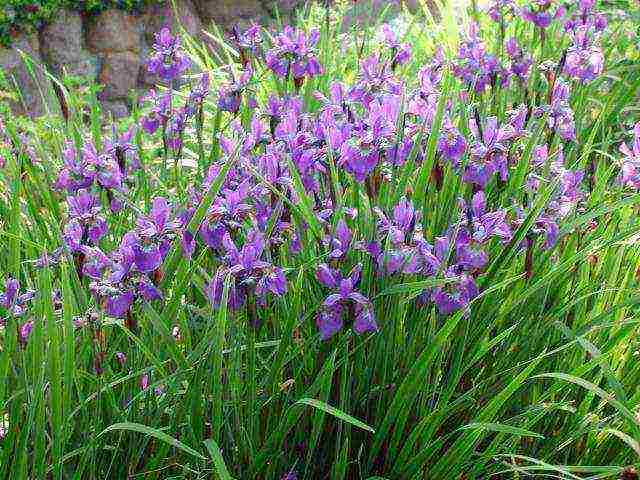 Profusely blooming iris
Profusely blooming iris
Hybrids of medium-sized bearded irises include:
"Bronzaire"
A variety that has golden-bronze flowers with brown beards and grows up to 50 cm tall.
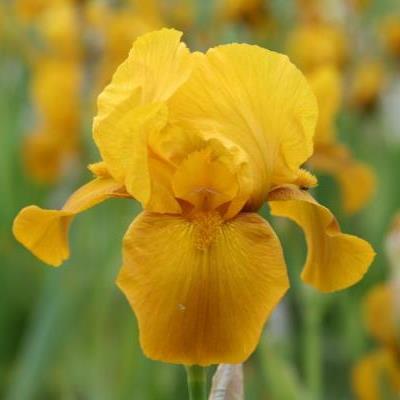 Golden bronze flowers
Golden bronze flowers
"Curlew"
Pure yellow flowers with white stripes on the fouls. Reaches 48 cm in height.
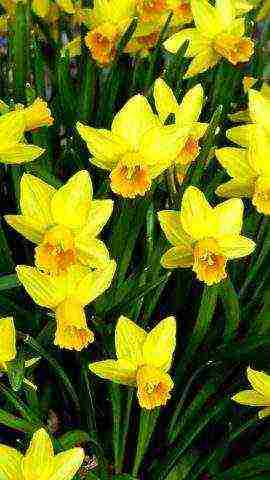 Pure yellow flowers
Pure yellow flowers
"Honey Glazed"
The variety forms white-yellow-brown flowers with yellow-orange beards and grows up to 70 cm.
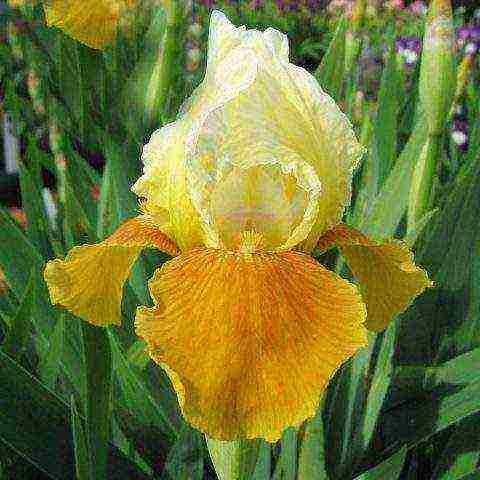 White-yellow-brown flowers
White-yellow-brown flowers
"Maui Moonlight"
The cultivar has bright lemon flowers with a lighter sheen and lemon yellow beards. It grows up to 65 cm.
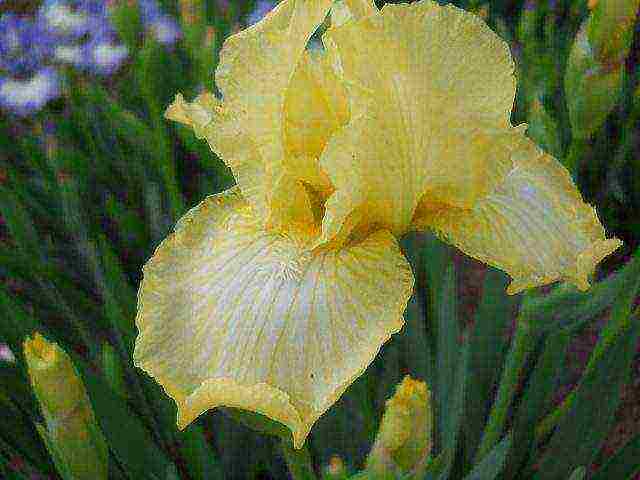 Bright lemon flowers
Bright lemon flowers
"Miss Carla"
The flowers are creamy with a shade of blue and blue beards. The plant reaches 55 cm.
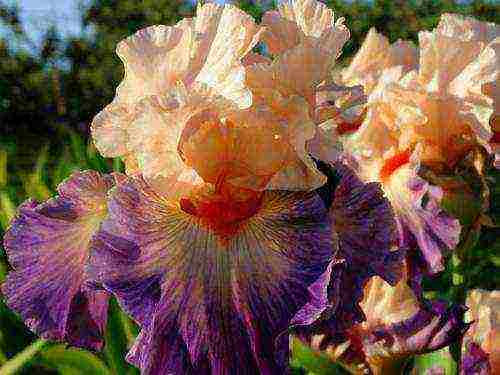 The flowers are creamy with a shade of blue
The flowers are creamy with a shade of blue
"Rare Edition"
The flowers are pink-purple and white with a lilac-purple border. Grows up to 60 cm.
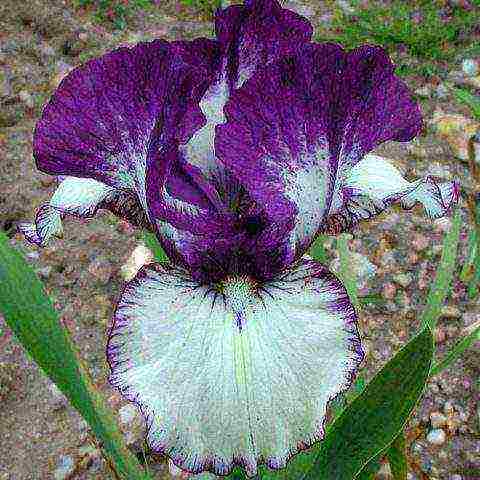 "Rare Edition"
"Rare Edition"
"Raspberry Blush"
The flowers are lilac-pink with a raspberry-pink spot and a pinkish-red beard. Plant up to 50 cm high.
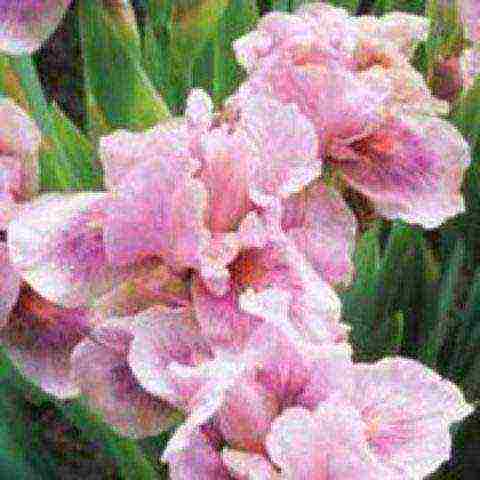 Lilac-pink flowers
Lilac-pink flowers
- Border bearded (BB)
These are low-growing types of tall, bearded irises that bloom in late June. They are usually not widely available. They are bred by professional collectors.
- Miniature Tall Bearded (MTB)
These miniature types of tall, bearded irises form flowers 5-6 cm in diameter in mid-June. They form thin stems and short leaves. Plants reach 38-63 cm in height.
I. pallida ssp. cengialtii (I. pale)
On branched stems, up to six fragrant blue-violet flowers are formed. The species is not hardy enough in the middle zone of Russia. Homeland - S. Italy, Balkans. Height - 45 cm.
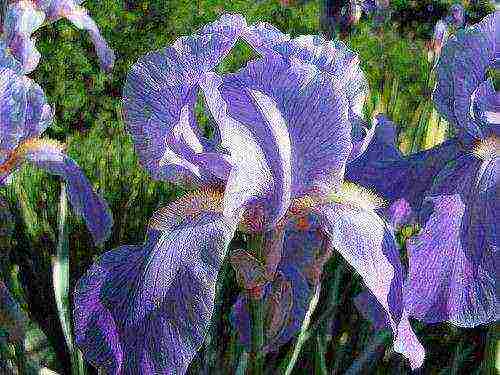 I. pallida ssp. cengialtii
I. pallida ssp. cengialtii
These powerful irises are especially prized for cutting. Flowers 10-15 cm in diameter, bloom from mid-June. Most plants are about 1 m tall, but different varieties can be 70 to 1.5 m tall.
I. pallida (I. pale)
Among the blue-green leaves, six fragrant light lavender-blue flowers form on each branched peduncle. A good plant for curbs and cutting. It is widely grown in the south of Russia, but in general, winter hardiness is low. Homeland - the Adriatic coast. Height - up to 1 m.
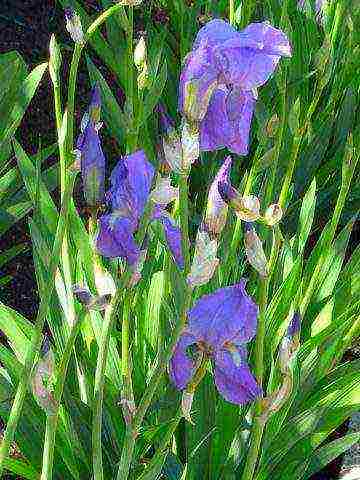 Good plant for curbs
Good plant for curbs
"Argentea Variegata"
The litter has white-striped leaves and grows more slowly than the original form.
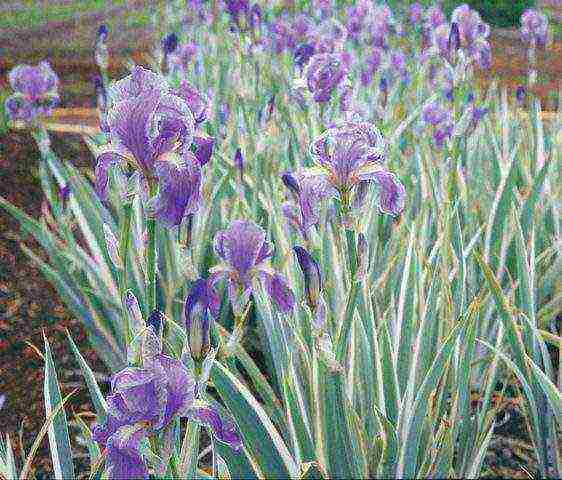 White striped leaves
White striped leaves
"Aurea Variegata"
Variety with golden yellow or cream stripes, grows relatively quickly, blooms regularly.
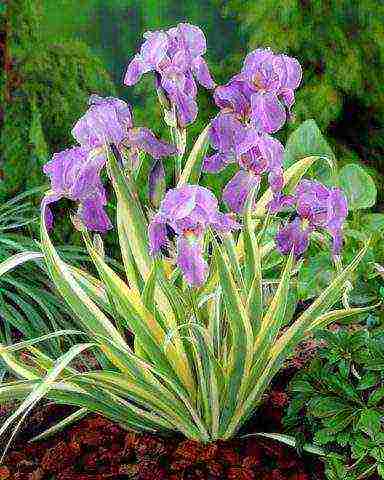 Variety with golden yellow stripes
Variety with golden yellow stripes
Рallida ssp. pallida (synonym J. pallida var.dalmatica) (I. pale variety Dalmatian)
Similar to a species plant, but more hardy and stable in adverse weather conditions. Low winter hardiness. From thousands of garden varieties of irises, you can choose from all the colors of the rainbow except for pure red. It is important to know the expected height of the plant before purchasing, as the number of flowers per stem varies from 6 to 15 depending on the height. The more flowers there are, the longer the flowering season.However, one of the main advantages of irises is the elegance and grace of individual flowers, so their excess on the stem can create a feeling of crowding, and the lack of it can lead to the flower looking poor and its flowering will be too short. 8-9 flowers per stem are considered ideal for a garden, the flowering season in this case is quite long, and each flower is clearly visible. All of the varieties listed below usually form 7-9 flowers or more. Flower buds are laid on the rhizome in the previous summer. It is especially beneficial if it was dry and hot.
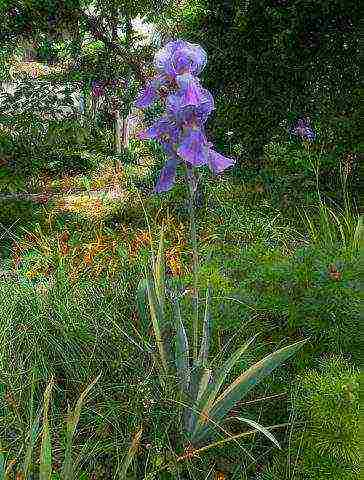 Рallida ssp. pallida
Рallida ssp. pallida
Modern hybrids have large corrugated flowers of pure flowers on powerful stems.
"Blue Rhythm"
The variety has blue flowers.
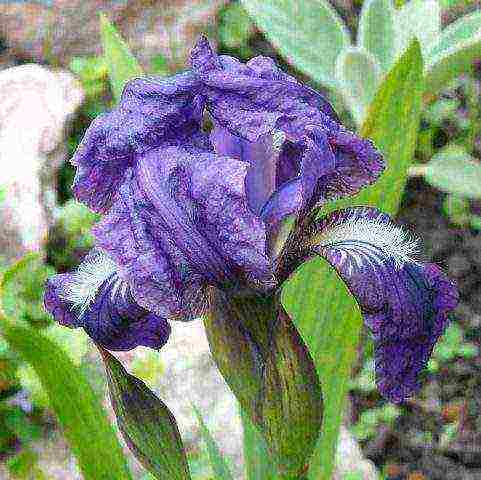 Blue flowers
Blue flowers
Special terms have been developed to describe color combinations of hybrids with mixed colors. Irises with white standards and colored fouls are called Atoena (Amena).
"Sun Dappled"
The variety has white standards and yellow fouls.
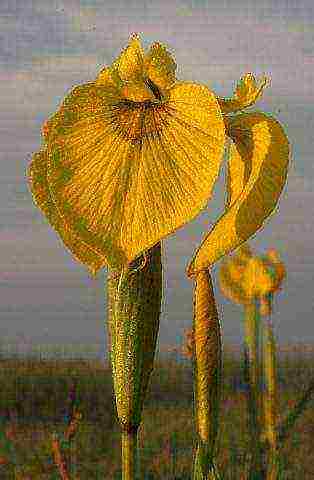 "Sun Dappled"
"Sun Dappled"
"Champagne Elegance"
A variety with white standards and pink-peach fouls.
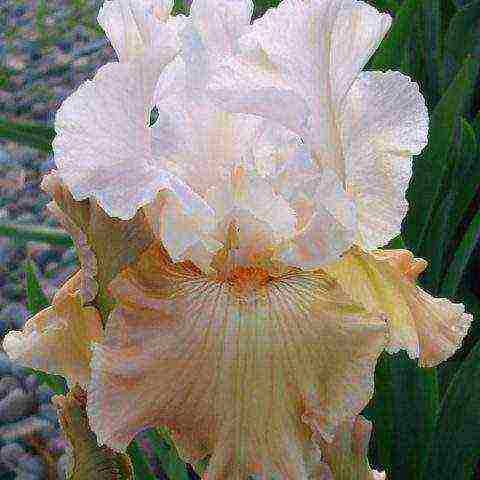 "Champagne Elegance"
"Champagne Elegance"
The term Bitone refers to flowers in which two tones of the same color are present. The two-tone blue-violet flowers are known as Neglecta (Simple). Varieties with two-tone flowers include:
"Gay Parasol"
A variety having mauve white standards and pink-purple fouls.
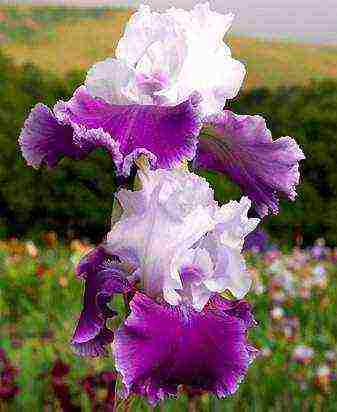 "Gay Parasol"
"Gay Parasol"
"Mystique"
A variety with light blue standards and dark purple fouls.
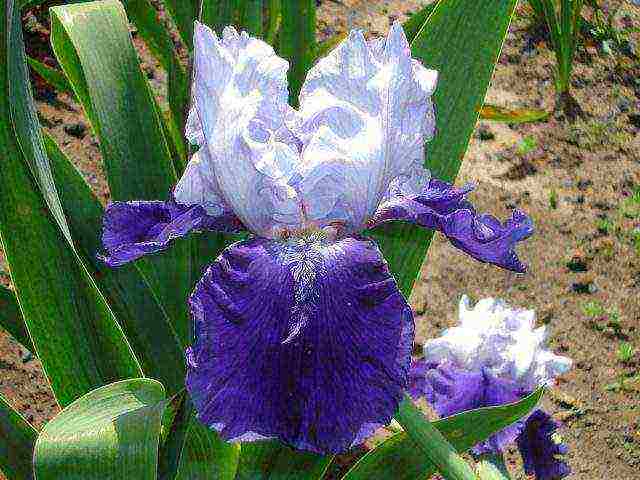 Variety with light blue standards
Variety with light blue standards
"Pasco"
The cultivar produces light lavender standards and deep purple fouls.
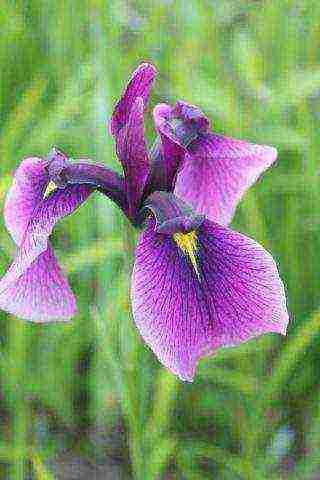 Light lavender standards
Light lavender standards
"Warleggan"
The variety has bluish white standards and blue fouls.
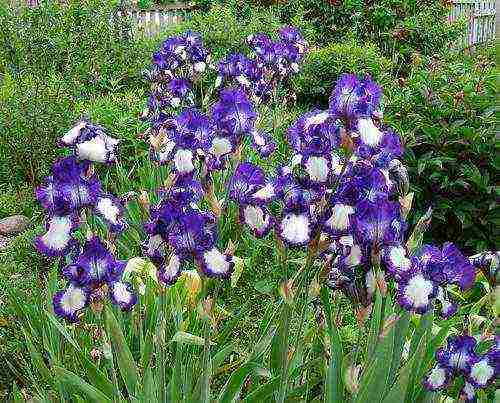 Bluish White Standards
Bluish White Standards
Two-tone irises are called irises, in the color of which there are two different colors.
"Edith Wolford"
The cultivar has dark yellow standards and purple fouls.
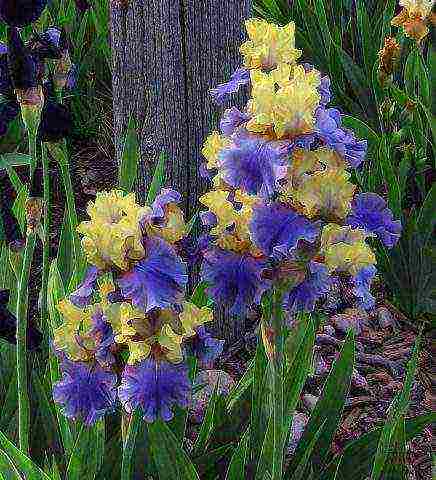 Dark yellow standards
Dark yellow standards
The terms M. Plicata (Plikata) designate flowers in which along the edges of the perianth leaves there is a border of dots and strokes of a darker color. For example, a white center and a blue, purple or wine red border can be found in Dancer's Veil, Going My Way, and Stepping Out. This is a cold scale. The center does not have to be white. A yellow or pink background with a wine-red, brown or pink border is typical for warm Plikats.
Beardless irises
Beardless irises are so named because they do not have hairs or ridges on fouls. Their fouls are smooth and attract insects to the center of the flower with a special “signal” (a spot in the upper part, painted in different colors), which can be developed to a greater or lesser extent. Rhizomes in beardless irises are usually thinner than in bearded ones and in most cases are buried in the soil rather than lying on the surface.
The numerous types of beardless irises are conveniently divided into five groups: Californicae, Hexagonae, Laevigatae, Sibiricae, and Spuriae. In addition, there is also a mixed group Miscellaneous, containing species that are not included in any of the five main groups.
- California irises (Californicae)
11 species of irises, known as Pacific Coast Irises (PCI), originate from the western coast of North America.
They grow best in acidic soil with diffused light, and their roots should be kept cool and not dry out. Plants grow well under trees.
The height of the varieties is 15-60 cm. Despite the relationship with Siberian irises, their winter hardiness is generally lower. Californian-Siberian hybrids (kalsibs), which are more resistant to cold, have also been obtained. In general, the success of growing in central Russia depends on the successful choice of the species and variety. Plants bloom in June.
I. douglasiana (I. Douglas)
Each branched stem bears 4-5 flowers 7.5 cm in diameter. The color can be different, but usually in blue-violet and lavender tones with prominent veins on the fouls. A species that carries limestone soils. Homeland -California.Plants are planted 60 cm apart. Height -30-45 cm.
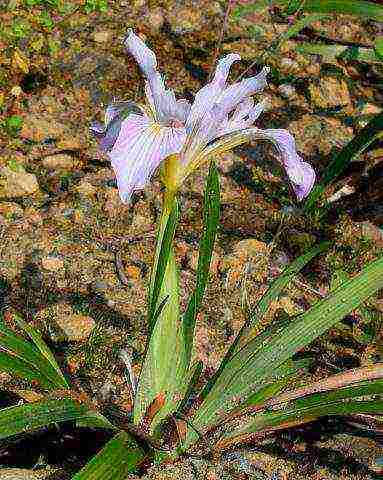 I. douglasiana
I. douglasiana
I. innaminata (I. unnamed)
Each stem bears 1-2 flowers more often. Flowers up to 6 cm in diameter, with wide creamy, dark yellow, yellow or orange segments of the perianth with dark brown veins. The leaves are narrow, in areas with a very mild climate, they remain for the winter. The species is variable. Homeland -Oregon. They are planted at a distance of 23 cm from each other. Height - up to 15 cm.
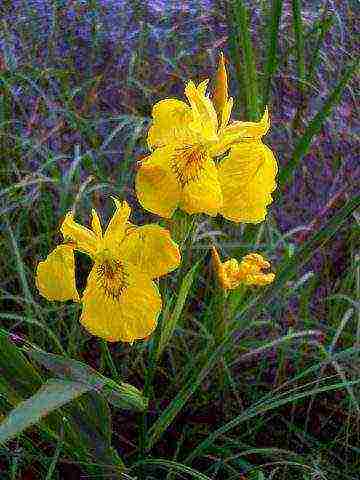 Leaves are narrow
Leaves are narrow
The hybrids of the Californicae Group include:
Banbury Beauty
Variety with lavender flowers and vibrant dark purple stripes and spots
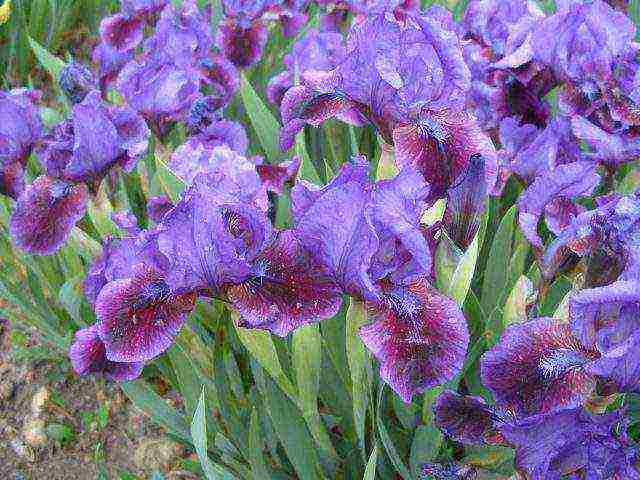 Variety with lavender flowers
Variety with lavender flowers
Banbury Melody
Variety with dark pink flowers with cream spots.
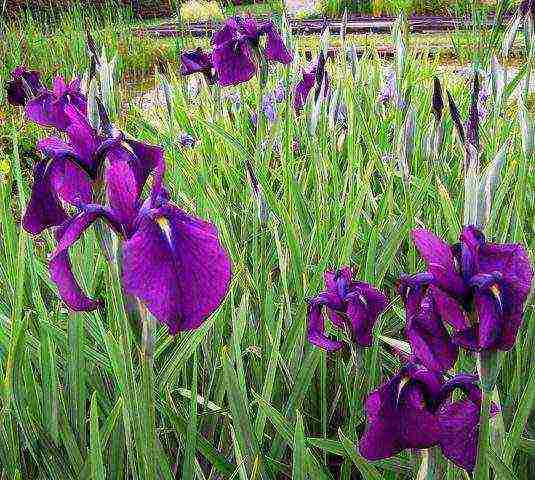 Banbury Melody
Banbury Melody
Broadleigh Carolyn
Pure blue flowers that form on very strong stems.
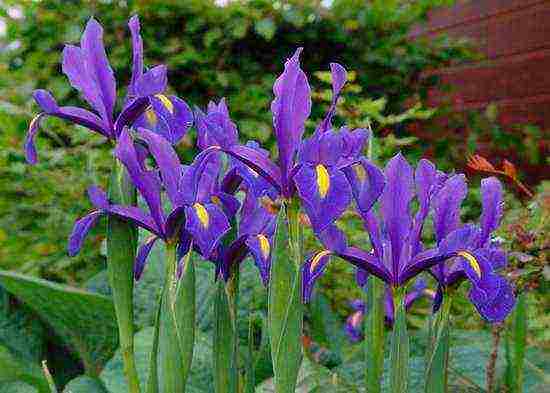 Broadleigh Carolyn
Broadleigh Carolyn
"No-name"
Variety with yellow flowers.
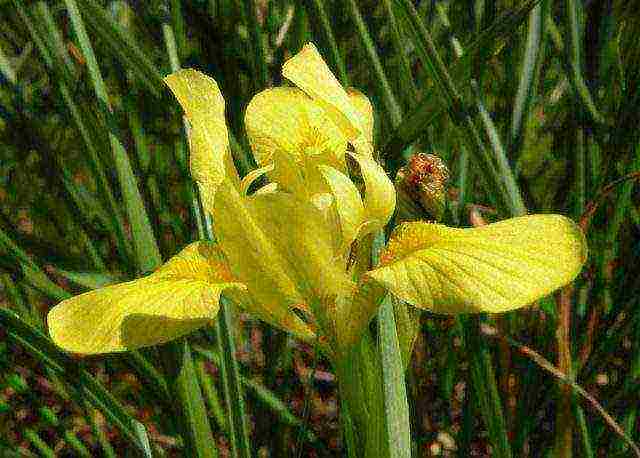 "No-name"
"No-name"
"Lavendar Royal"
The cultivar has light purple flowers with darker spots running along the center of the standards and fouls.
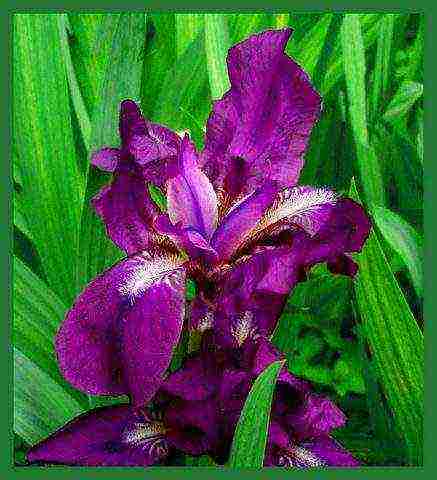 "Lavendar Royal"
"Lavendar Royal"
- Louisiana irises (Hexagonae)
Despite the fact that Louisiana irises are often supplied to Russia, these beautiful, powerful plants are not hardy enough to grow and bloom outdoors in the middle lane. They come from the Mississippi Delta and need a lot of humidity and high summer temperatures. They are best grown in a cool greenhouse where they will bloom from early to mid-summer. They are called hexagonal because their boxes have six faces.
I. fulva (I. brown-yellow)
Terracotta flowers, 7.5-10 cm in diameter, are formed in the axils of the leaves in early summer. The plant blooms only under suitable conditions. Homeland - New Orleans. Height-45 cm.
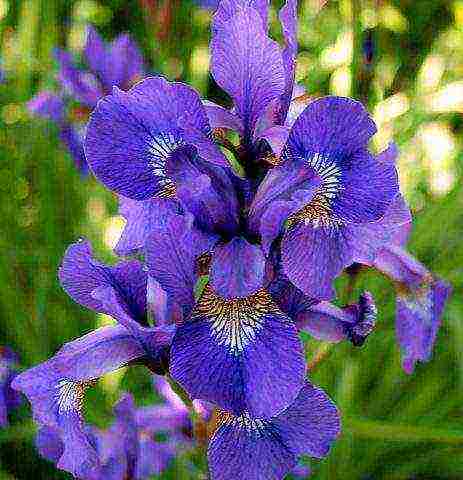 Terracotta flowers
Terracotta flowers
I. fulvala (hybrid of I. brown-yellow and I. short-stemmed)
Blooms steadily, forming red-violet or blue-violet flowers, 10 cm in diameter, in mid-summer. Height - 60 cm.
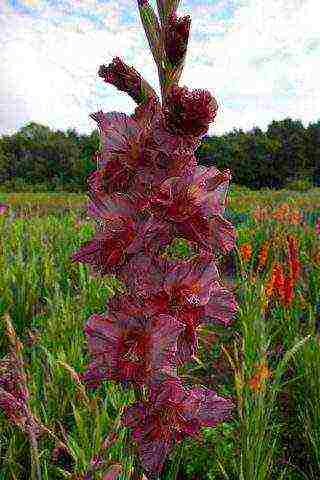 I. fulvala
I. fulvala
- Water-loving irises (Laevigatae)
This group includes irises that grow and bloom in or near water. There are five common species that have hybridized to form a significant number of varieties. Especially many varieties come from I. ensata (I. xiphoid) originally from Japan. Only I. laevigata (I. smooth) and T. pseudacorus (J. marsh) can be grown in water. All other irises are planted in ordinary garden soil, making sure that it does not dry out in summer.
I. ensata (synonym J. kaempferi) (I. xiphoid, I. Kampfer)
The flowers are dark purple, appear from early to mid-summer, 2-3 on the stem, have short standards and wide fouls with a yellow stripe or shine. The plant differs from other species of the Laevigatae group by the absence of black watermarks on the leaves, which have strongly protruding veins.
This plant is more common on the shores of water bodies (but not in water!) And does not tolerate lime.
In central Russia, it requires a dry winter shelter. Height - 0.6-1 m.
From this species came a huge number of varieties known as Japanese irises. The color of the flowers is varied: they can be blue, red-violet, pink, lavender and white. Color combinations are frequent. There are monochromatic varieties and varieties with mixed colors, spots and stripes, with colored veins. Flowers 10-20 cm in diameter, can be single, semi-double or double.
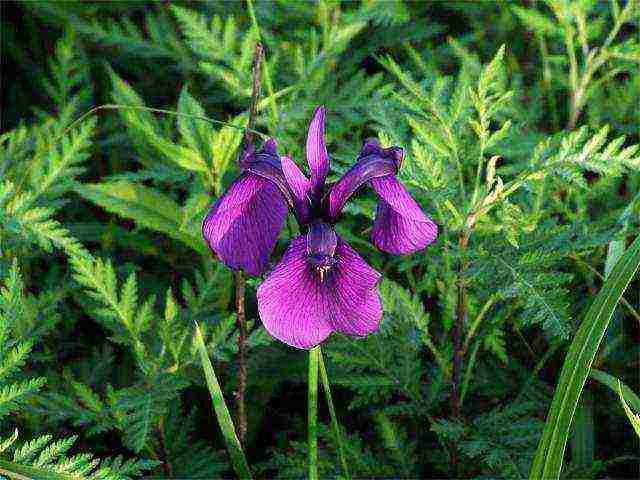 I. ensata
I. ensata
"Variegata"
Form with variegated white-gray-green leaves that contrast well with burgundy-purple flowers.
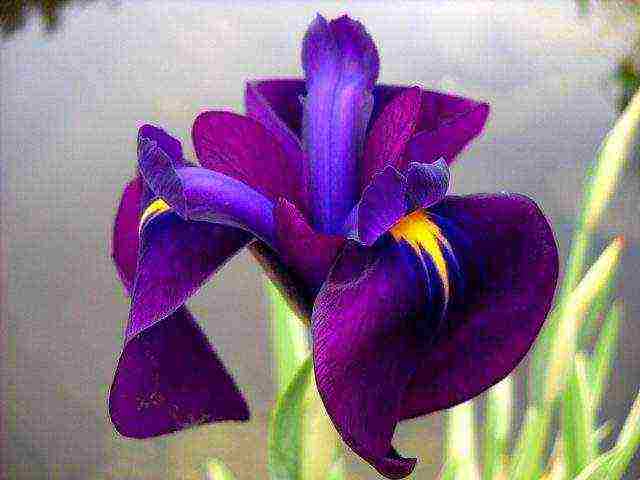 "Variegata"
"Variegata"
"Rose Queen"
The variety has light lavender-pink flowers. Varieties and forms, as a rule, are less hardy than the original species.
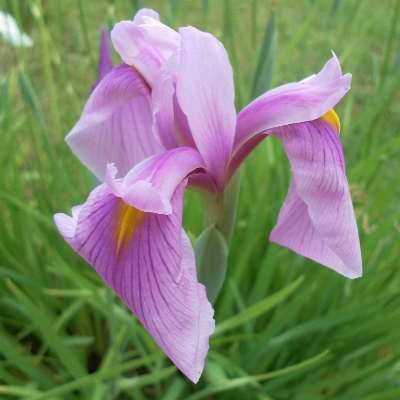 "Rose Queen"
"Rose Queen"
I. laevigata (I. smooth)
The flowers are blue, formed from early to mid-summer, four or more per stem. The leaves are light green with black watermarks on the veins. Fast growing plant, tolerates soil with little lime content. Homeland - Russia, Manchuria, Korea and Japan. Good winter hardiness. Height - 45-60 cm when landing in water to a depth of 15 cm.
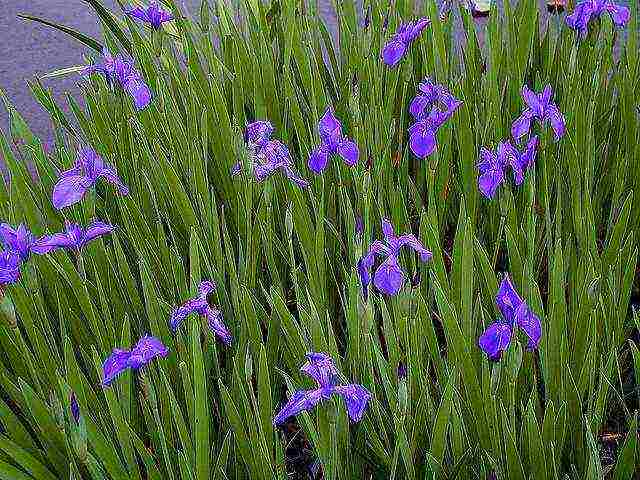 I. laevigata
I. laevigata
I. pseudacorus (I. false, I. swamp)
A widespread natural species in Russia with yellow flowers up to 12 cm in diameter, which are formed in June. A very large plant, perhaps too large for small gardens. Height varies from 60 cm in dwarf forms to 2 m in plants with normal height.
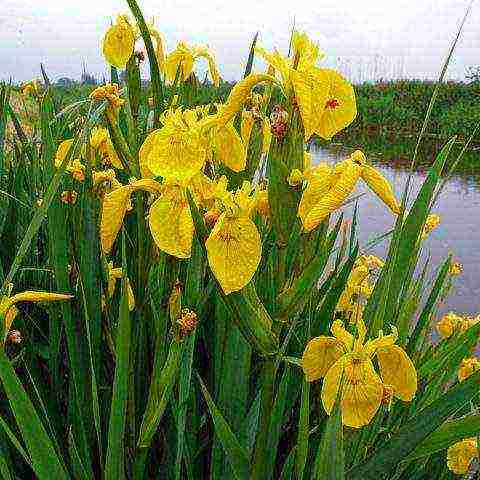 I. pseudacorus
I. pseudacorus
"Variegata"
Spring leaves are striped with green and cream stripes, but by early summer, when the plant forms yellow flowers, the pattern fades and the leaves take on the color of fresh greenery. Plant up to 1 m tall.
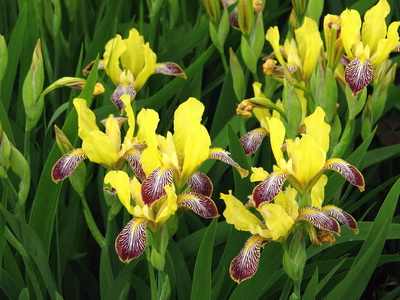 "Variegata"
"Variegata"
There are forms with cream, lemon, white and golden yellow flowers. They all have black watermarks on their leaves.
Holden Clough
The cultivar resembles a small I. pseudacorus, but its yellow flowers have crimson-brown veins, and from a distance it seems that the flowers are brown. Good for cutting. The plant is 60-75 cm tall.
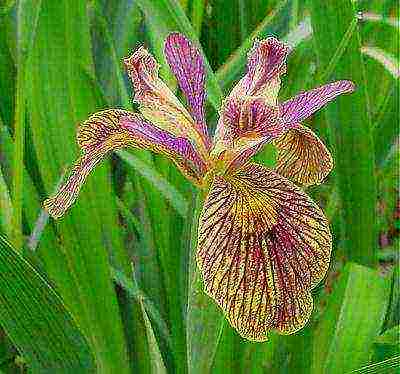 Holden Clough
Holden Clough
I. versicolor (I. multicolored)
On a branched stem, up to nine blue or red-violet flowers are formed. Standards are shorter than fouls. The plant forms shiny seeds and black watermarks on the leaves. It grows well in water or moist soil and tolerates a small amount of lime. Homeland -S. America. Height - 60 cm.
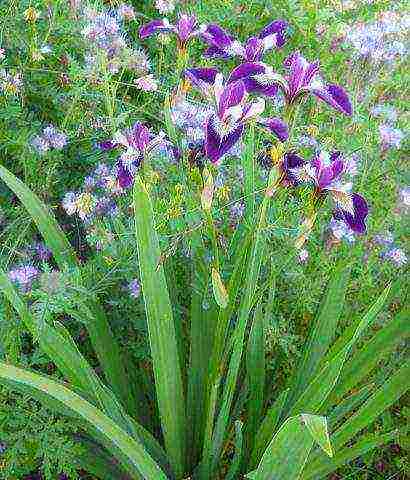 I. versicolor
I. versicolor
I. virginka (I. virginsky)
The color of the flowers ranges from dark blue to wine red, standards and fouls are of the same length. Up to nine flowers are formed on each branched stem. The plant grows best in water or moist soil and tolerates a small amount of lime. Leaves have black watermarks. Homeland -S. America. Height - 50-75 cm.
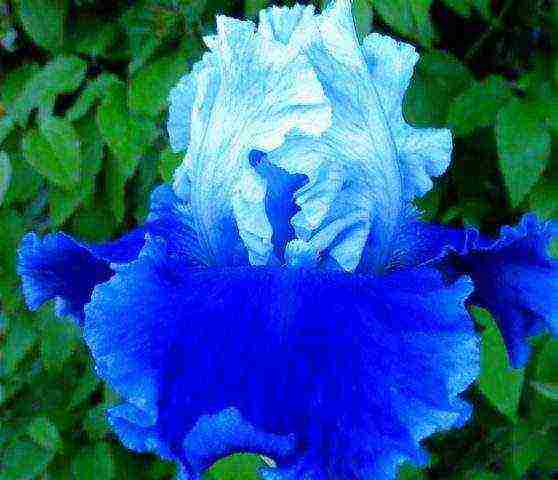 I. virginka
I. virginka
Gerald Darby
Bright blue flowers and black-purple stems that can grow up to 90 cm.
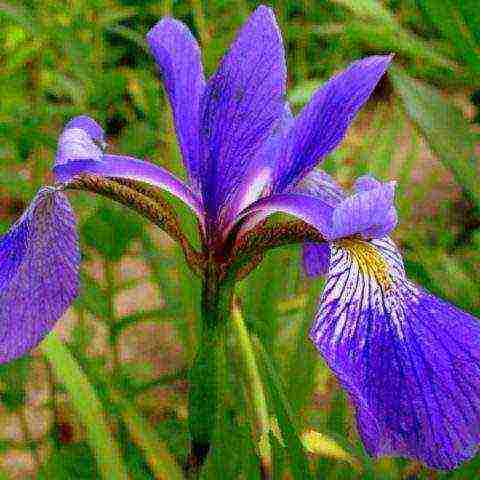 Gerald Darby
Gerald Darby
- Siberian irises (Sibiricae)
These are the most winter-hardy of irises and grow well in grassy mixborders with not too dry soil. They can be used to frame ponds where they add naturalness to the landscape. But remember that Siberian irises cannot stand waterlogging. The leaves are gramineous, thin and elegant. The stems that rise above the leaves range from very short for forms suitable for rocky gardens to 1.2 m for specimens that can be grown anywhere in the garden with adequate sunlight.
I. sanguinea (I. blood red)
Unbranching stems, in early summer form two blue-violet flowers, up to 7.5 cm in diameter. Homeland - Siberia, Manchuria and Japan. Height - 1 m.
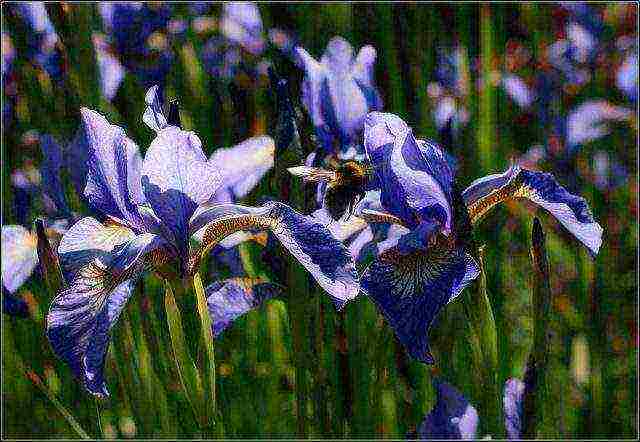 Non-branching stems
Non-branching stems
I. sibirica (I. siberian)
In early summer, up to five flowers are formed on stems with 1-2 branches, the color of which varies from white to blue. Homeland -Russia, Europe, Turkey. Height - 1 m.
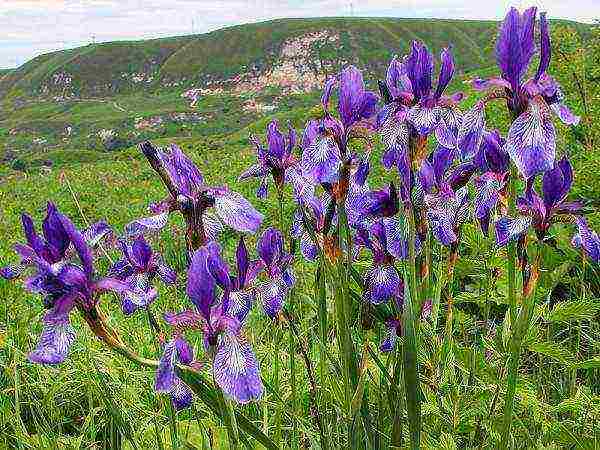 I. sibirica
I. sibirica
From these two species came the modern hybrid - Siberian irises. Their color varies widely, and the flowers, up to 10 cm in diameter, are larger, wider and corrugated.
In the listed varieties, peduncles reach 60-100 cm in height and form 2-5 flowers:
"Anniversary"
The flowers are white;
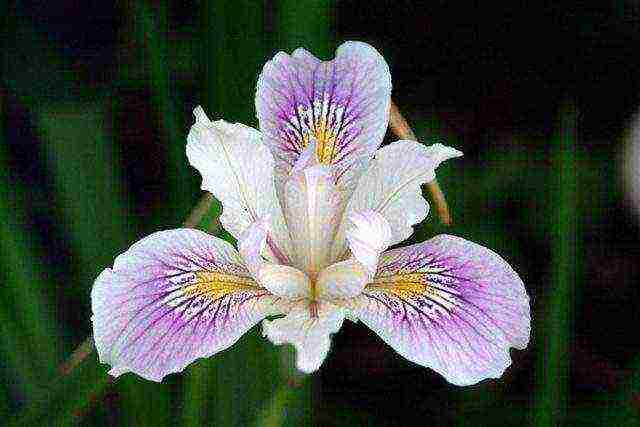 "Anniversary"
"Anniversary"
"Butter Sugar"
The flowers are white-yellow;
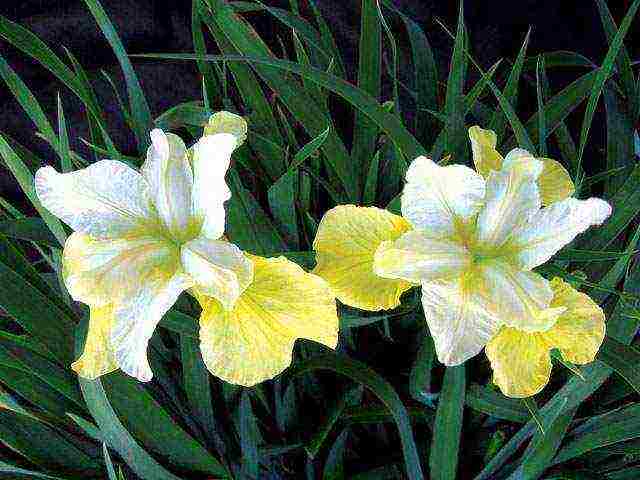 "Butter Sugar"
"Butter Sugar"
"Cambridge"
The flowers are light blue;
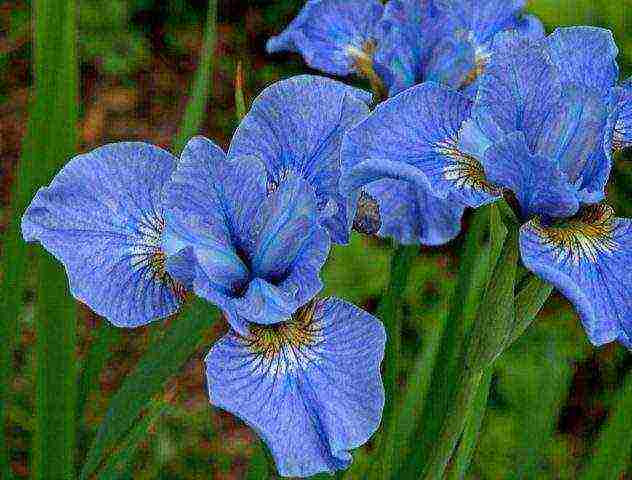 "Cambridge"
"Cambridge"
"Dreaming Yellow"
The flowers are white-lemon yellow;
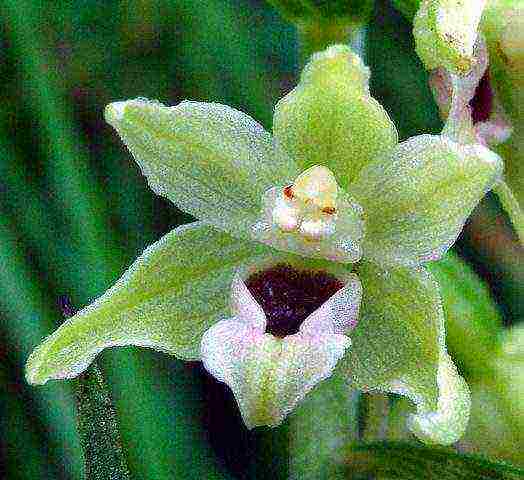 "Dreaming Yellow"
"Dreaming Yellow"
"Limeheart"
Flowers with a greenish-white center;
 "Limeheart"
"Limeheart"
Orville Fay
Flowers in different shades of blue;
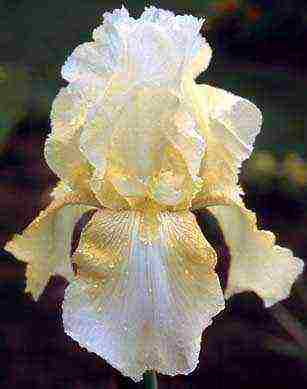 Orville Fay
Orville Fay
"Ruffled Velvet"
The flowers are corrugated dark purple;
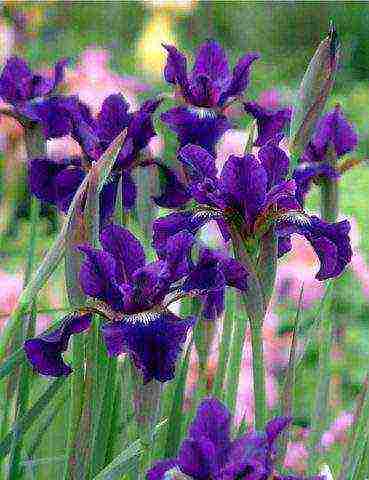 "Ruffled Velvet"
"Ruffled Velvet"
"Shirley Pope"
The flowers are dark purple with white spots in the fauces;
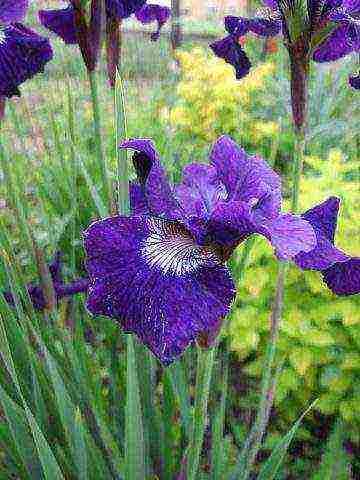 "Shirley Pope"
"Shirley Pope"
"Silver Edge"
The flowers are dark blue with white edges;
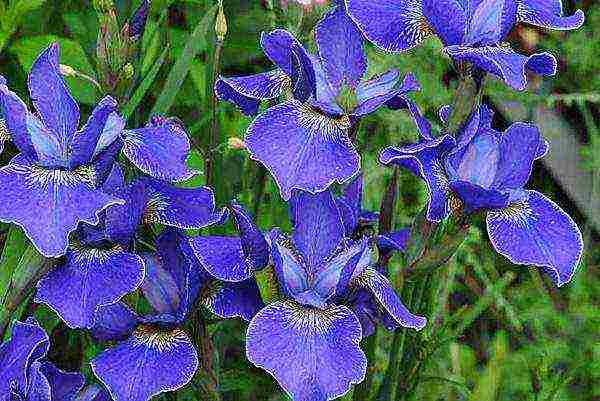 "Silver Edge"
"Silver Edge"
"Soft Blue"
The flowers are light blue, formed early;
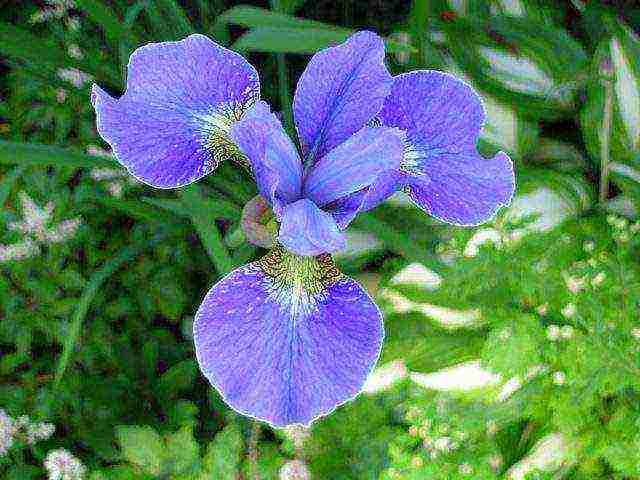 "Soft Blue"
"Soft Blue"
"White Swirl"
The flowers are white;
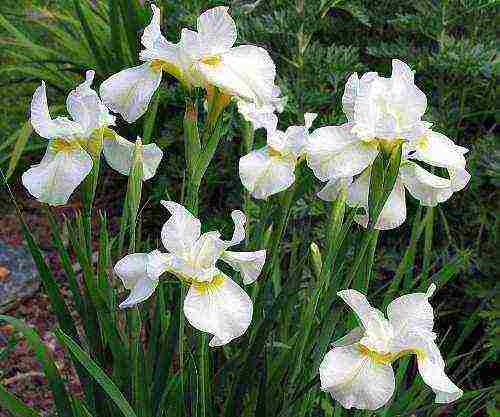 "White Swirl"
"White Swirl"
"Wisley White"
The flowers are white;
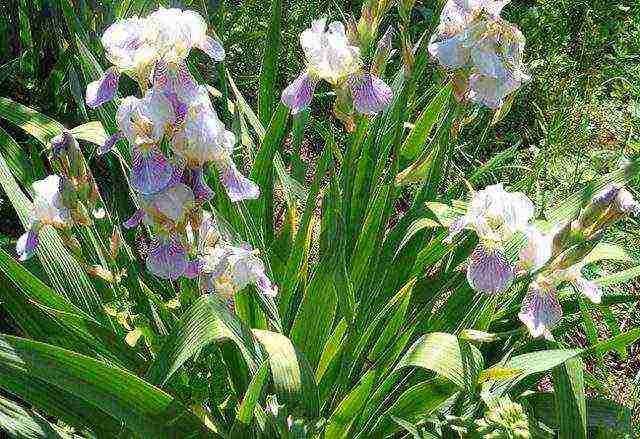 "Wisley White"
"Wisley White"
Siberian irises also include a group of species that require higher humidity - the Chrysographes sub-series, a typical representative of which is golden-painted iris. These irises can also hibernate outdoors without shelter.
I. chrysographes (I. golden-painted)
The flowers are dark, wine-red or purple-black, with golden spots on the fouls, up to 6 cm in diameter. Flowers form two per stem in early summer. Homeland - the Chinese provinces of Sichuan, Yunnan and Burma. Height - 36 cm.
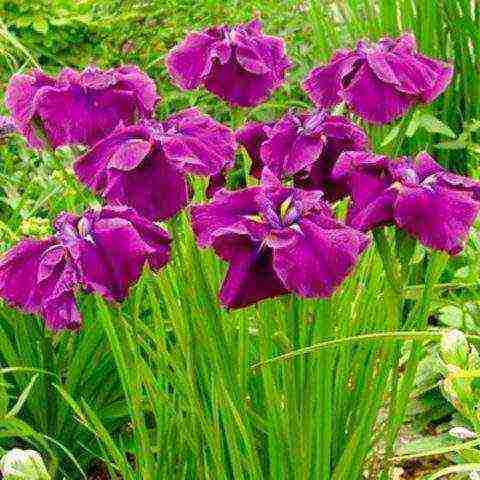 The flowers are dark, wine-red
The flowers are dark, wine-red
I. forrestii (I. Forrest)
The flowers are yellow, 5 cm in diameter, with black strokes on the fouls, formed in early summer. Standards are placed vertically above drooping fouls. Homeland - Yunnan Province. Height - 20-45 cm.
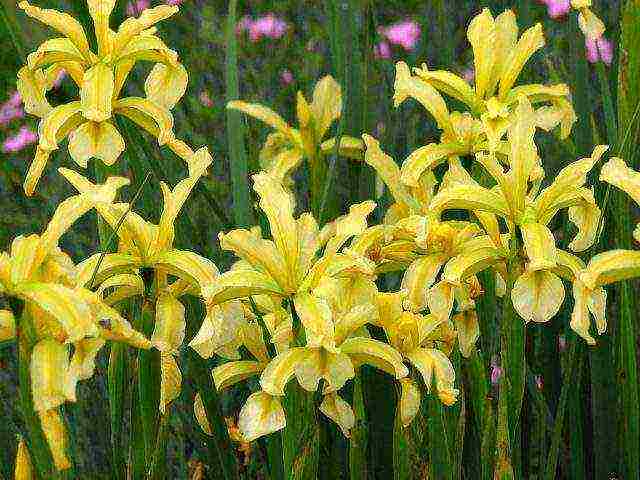 I. forrestii (I. Forrest)
I. forrestii (I. Forrest)
Spuria irises (Spuriae)
Flowers 6-10 cm in diameter, with narrow vertical standards and oval fouls.These hardy, winter-hardy plants thrive in full sun and partial shade, both on calcareous and lime-free soil, in wet and dry conditions. Height varies from 15 cm to 1.8 m, in most plants 40-100 cm. Leaves are usually shiny green, thin.
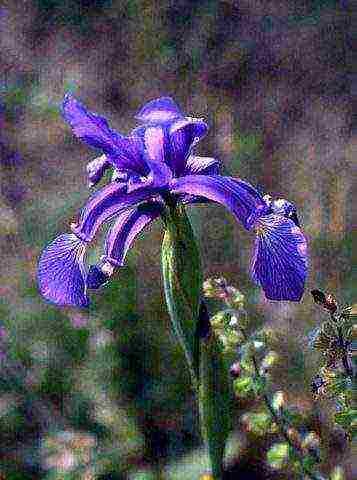 Spuria irises
Spuria irises
I. graminea (I. cereal)
The flowers are blue-violet, formed in early summer under the grass-like leaves, two per stem. Homeland -Europe. Height - 25-38 cm.
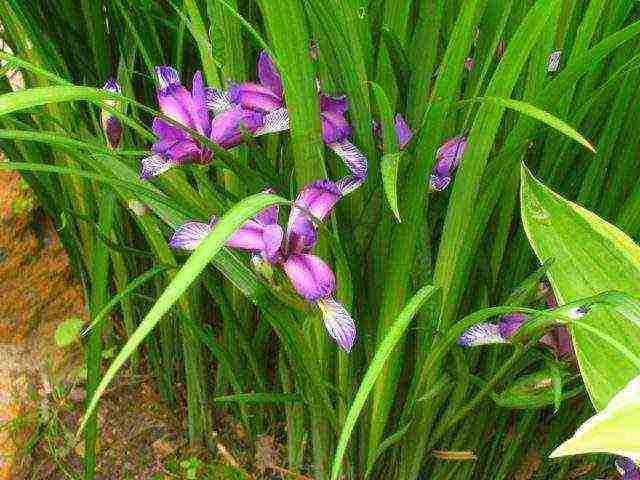 I. graminea
I. graminea
I. kerneriana (I. Kerner)
The flowers are light, creamy lemon, 5-7.5 cm in diameter, formed in late spring - early summer, have strongly bent back fouls, which usually touch the stem. Height - 30-38 cm.
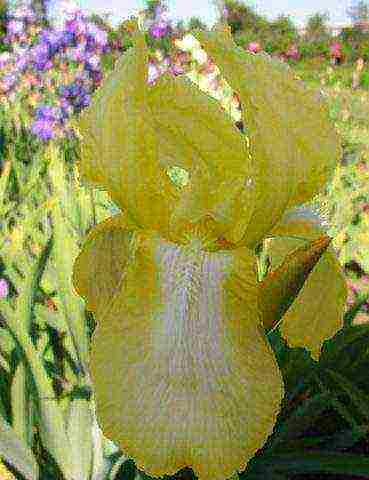 The flowers are light, creamy lemon
The flowers are light, creamy lemon
I. orientalis (synonym I. ochroleuca) (I. oriental)
The flowers are large, white, with a yellow spot on the foliage folded back. Flowers form from early to mid-summer, 4-9 on the stem, which rises above the shorter leaves. Homeland -Turkey. Height - 1-1.2 m.
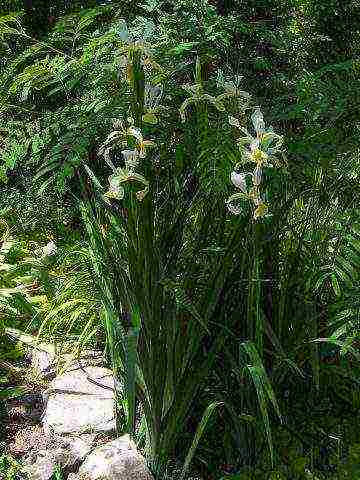 The flowers are large, white
The flowers are large, white
Shelford Giant
Yellow flowers. The variety reaches 1.8 m in height.
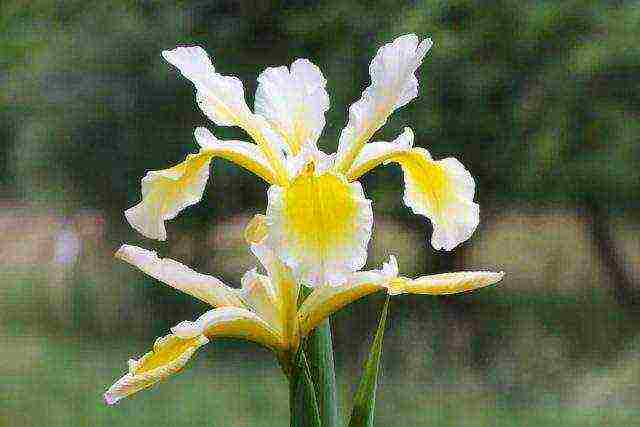 Shelford Giant
Shelford Giant
I. spuria (I. false)
Up to 10 violet-blue, yellow or white flowers are formed on each stem of this light-grown plant in mid-summer. Homeland - Europe and the Middle East. Height - 50-75 cm.
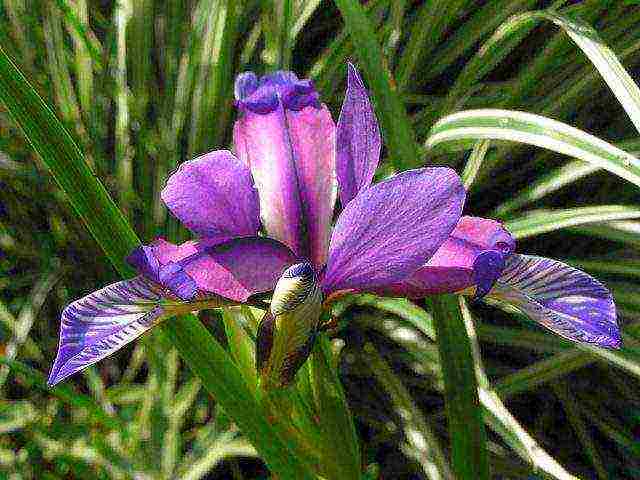 I. spuria
I. spuria
Existing garden hybrids of false iris form flowers in the color of which colors and color combinations vary widely. Most of them are 1-1.2 m tall, but there are also shorter plants.
"Adobe Sunset"
Dark orange-yellow flowers with brown edges and veins. The plant reaches 1.8 m in height.
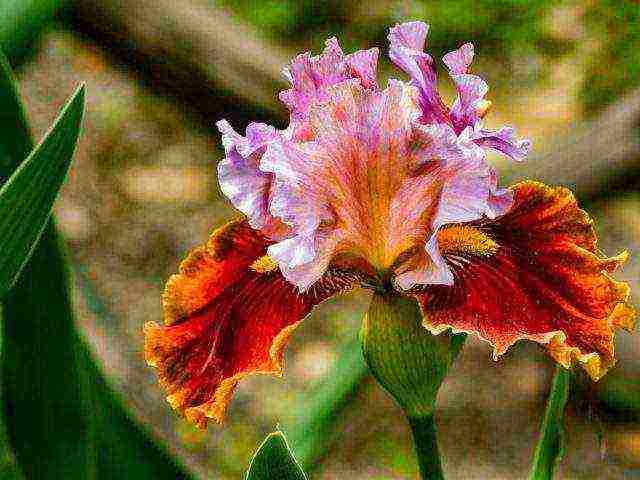 "Adobe Sunset"
"Adobe Sunset"
A number of beardless irises do not fit any of the groups. Some are very difficult to grow, but the irises below are great garden plants.
L. foetidissima (I. stinky)
The species is grown in warm climates, mainly for the bolls, which develop after flowering and open up in autumn and winter, exposing orange-scarlet seeds. Their flowers are inconspicuous, up to 7.5 cm in diameter, bluish-gray with pink and brown blush, formed in early summer by 2-9 on the stem. The leaves are evergreen, dark green, shiny, give off an unpleasant odor when rubbed. Homeland - Britain and other areas of Europe. This species is often supplied to Russia, but in the open field it can only be grown on the Black Sea coast. Height - 50 cm.
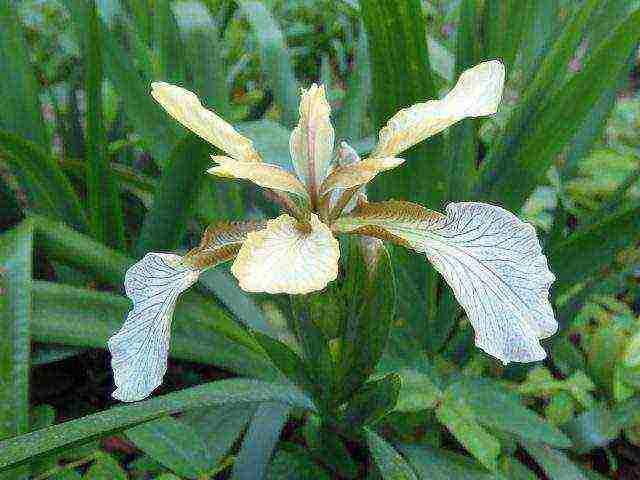 L. foetidissima
L. foetidissima
J. f. ritrina
The variety has creamy yellow flowers.
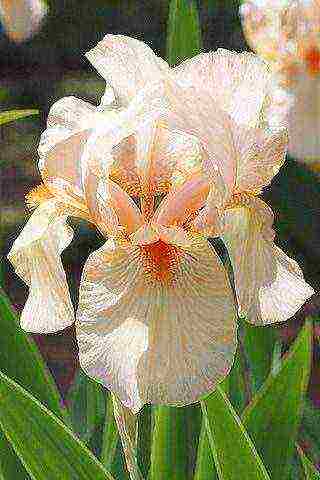 J. f. ritrina
J. f. ritrina
I. setosa (I. bristly)
The flowers are bluish-gray or dark purple and are formed in early summer. The standards are reduced to bristles and the fouls are wide. One of the most winter-hardy irises. Thrives on moist soil. Ideal for growing at the edges of ponds or streams. It is dug up and divided in early autumn. Homeland - Siberia, including Yakutia, Alaska. Height - 15-75 cm.
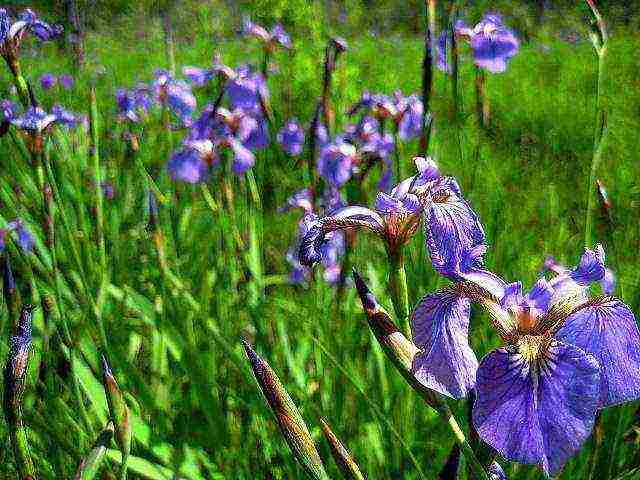 The flowers are bluish gray or dark purple
The flowers are bluish gray or dark purple
I. unguicularis (I. marigold)
The flowers are mauve-lilac, up to 7.5 cm in diameter, with yellow marks on the fouls. Flowering begins in autumn and, in mild climates, continues throughout the winter until March. Leaves can be unkempt, so they are usually cut in the fall before flowering.
The plant requires good sun exposure, the warmest and driest spot in the garden and some shelter from the cold winds in winter. The ideal location is the base of a south-facing wall.
Homeland -Mediterranean. It does not winter in central Russia. Height - 23 cm.
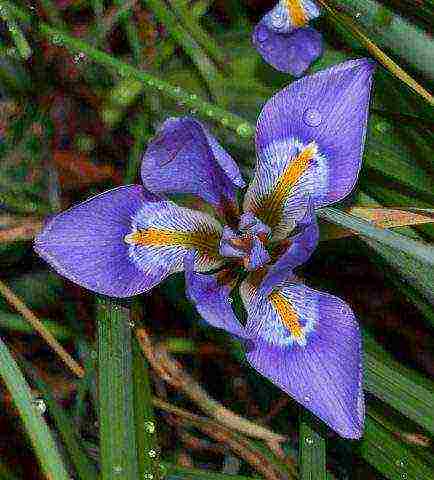 I. unguicularis
I. unguicularis
Comb irises
Crested irises have an apparent resemblance to bearded ones. The protruding tissue along the main vein of the fouls does indeed look like beards. Evergreen plants with thin rhizomes grow best in moist, organic-rich soil in a sheltered place in partial shade. In Russia, they do not hibernate in the open field. They are more suitable for a cool greenhouse or conservatory. The flowers are 4-7.5 cm in diameter, are delicately colored and quite graceful. The leaves are shiny, evergreen. Crested irises do not like transplants, and are severely damaged by snails and slugs.
I. confusa (I. mixed)
The flowers are white, 5 cm in diameter, with a yellow crest, bloom from early to mid-summer. An evergreen plant for a cool greenhouse. Height - 1 m.
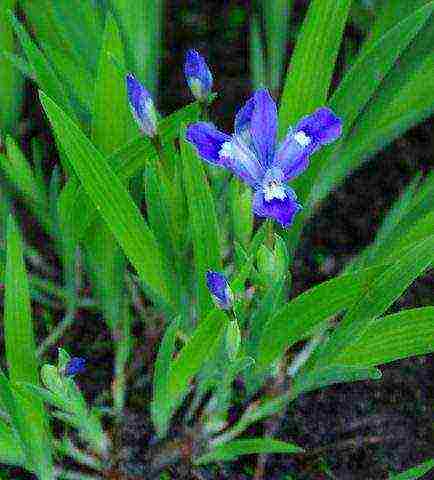 I. confusa
I. confusa
I. cristata (I. comb)
The flowers are light lavender, about 5 cm in diameter, with an orange crest, appear from mid to late spring. One of the most resistant species for a rocky indoor garden. Homeland - S. America. Height - 10 cm.
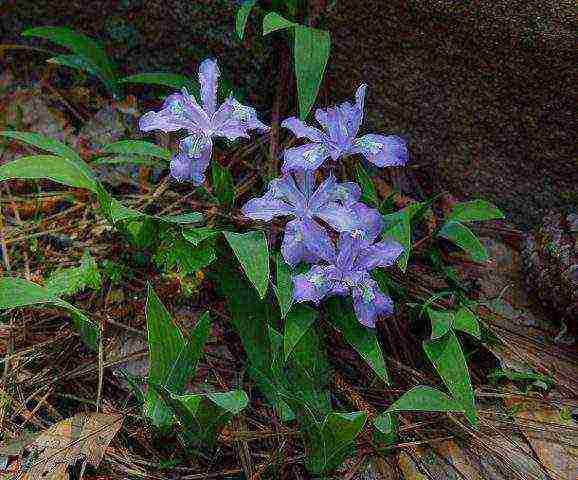 Light lavender flowers
Light lavender flowers
I. japonica (I. Japanese)
Dozens of small, light lavender flowers with purple and orange streaks form on highly branched peduncles from mid to late spring. Leaves are shiny, green, up to 45 cm long. Homeland - China and Korea. Height - up to 1 m.
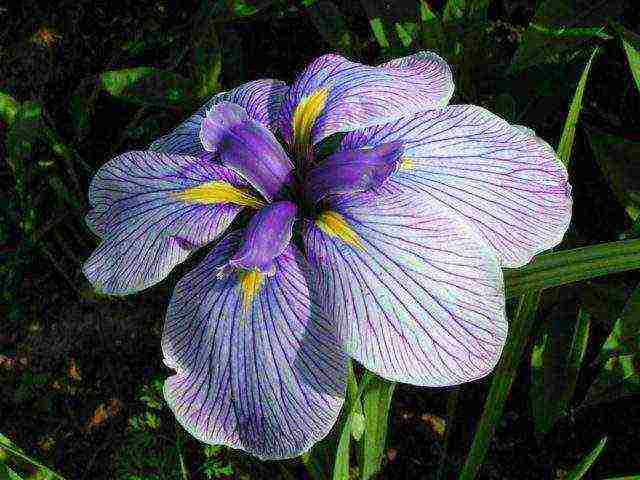 I. japonica
I. japonica
Ledger's Variety
The cultivar is slightly more resistant than the original form.
"Professor Blaauw’t"
Wedgewood
The variety is distinguished by lavender-blue flowers with yellow spots on light blue fouls.
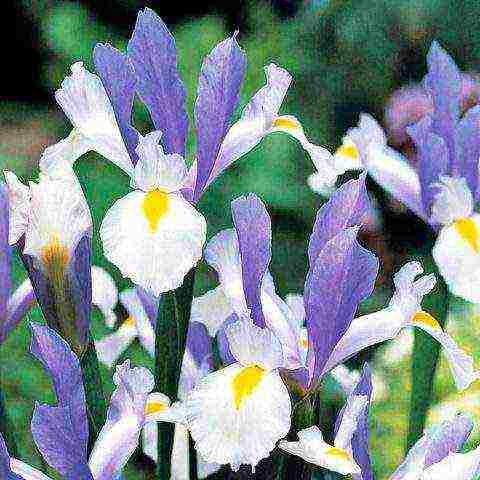 Wedgewood
Wedgewood
J. latifolia (synonym I. xiphioides) (I. broadleaf, English iris)
The flowers are large, 12.5 cm in diameter, formed on tough stems among narrow silvery-green leaves. The color varies from white to blue, pink and purple. Fouls with characteristic spots. Height - up to 65 cm.
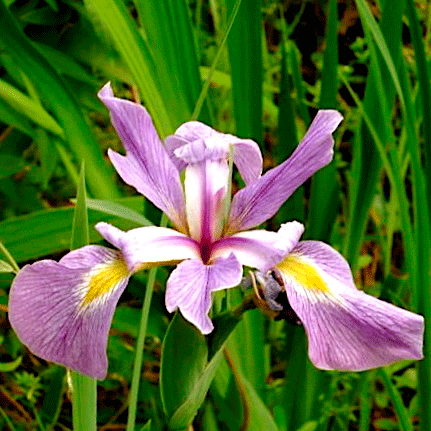 J. latifolia
J. latifolia
L. xiphium (I. xyphyum, Spanish iris)
The flowers are elegant, 10 cm in diameter, blue-violet, sometimes white. There are two-color kits with a yellow or orange spot on the fouls. Flowers are formed among narrow leaves. Bulbs are usually sold in a set of color mixtures. In cultivated forms, flowers are blue, purple, mauve, white, yellow and brown. Height - 60 cm.
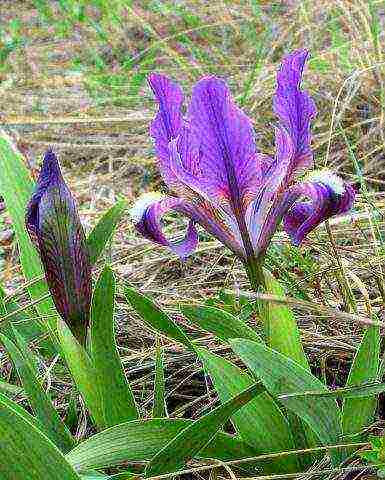 Flowers are elegant
Flowers are elegant
Growing
Requirements for growing irises vary depending on their classification - the relationship to the corresponding group.
Bearded irises
Most popular group. Most often, tall, bearded and medium-sized irises are grown. All bearded irises are photophilous, need shelter from cold winds, especially high ones, do not tolerate excessive moisture and close groundwater. In the middle lane, extra-class varieties of bearded irises need shelter for the winter. The leaves are pre-cut to a height of 15-20 cm and the rhizomes with flower buds are covered with a 15-20 cm layer of sand or dry peat. It is useful to additionally protect irises from winter moisture with roofing felt. In late April - early May, the shelter is removed, exposing the upper part of the rhizomes. Medium-sized irises in the middle lane are more resistant to frost and bacteriosis than tall, bearded ones.
During the growing season in hot weather, plants need watering, especially during the flowering period.
Tie cut varieties with massive peduncles to a support. Rhizomes are planted in open, sunny places with good drainage in mid-summer or early fall. Tall bearded irises are planted at a distance of 45 cm from each other, medium-sized bearded irises at a distance of 30-38 cm from each other and dwarf bearded irises at a distance of 15-23 cm from each other. The rhizomes are planted so that the upper part ("back") is above the ground, in the sun. In the first 2-3 weeks after planting, they must be well watered. On heavy soils or in damp places, they may need a raised flower bed 15-20 cm high. Plants grow well on heavy or light soil with good drainage and tolerate both acidic and alkaline soils. Neutral to slightly alkaline soil is considered the best, bearded irises are a good choice for chalky soils.
Beardless irises
Thin rhizomes of beardless irises are planted to a depth of 3-5 cm.
California irises
Plants are planted in acidic soil enriched with leaf humus. G. innominata needs full sun exposure, all other plants in this group like to have their roots in cool conditions and prefer light or partial shade. Californian-Siberian hybrids grow well in the middle lane.
Louisiana irises
In central Russia, the species offered here can bloom only in a cool greenhouse.In warmer areas, seed-grown plants are transplanted into shallow pots when they are large enough to be handled and planted in a permanent place, taking care not to damage the roots. The rhizomes are planted one at a time in mid-summer, just below the soil surface.
Ideal for them is a moist, but not damp, place sheltered from cold winds and humus-rich soil.
Water-loving irises
Rhizomes are planted to a depth of 5 cm in autumn or spring. They are placed in a fully sunlit place in acidic moist soil. I. laevigata and I. pseudacorus are real water irises that can be planted in a pond to a depth of 5-25 cm. I. ensata does not tolerate lime and requires soils rich in humus. This species, as well as varieties of Japanese garden irises, are characterized by low frost resistance, need shelter for the winter with spruce branches and roofing felt, and during the flowering period, in abundant watering. Sometimes it is affected by fungal diseases, so it is not possible in all places. For cultivation in central Russia, varieties of domestic selection are preferred. Siberian irises Rhizomes are planted in a fully sunlit place in moist, but not swampy, neutral or acidic soil to a depth of 2.5 cm and at a distance of 45-60 cm from each other. The best planting time is from mid-summer to early fall.
Plants need enhanced nutrition, it is advisable to use organic fertilizers and mulch the soil regularly.
Do not loosen the soil to avoid damaging the surface roots. The varieties of Siberian irises are unpretentious and frost-resistant, do not require frequent transplants, and generally grow well in the conditions of central Russia.
Plants belonging to the Chrisographes group prefer moist, neutral or acidic soils.
Irises-Shuria
In central Russia, these irises are as unpretentious as Siberian ones. Their rhizomes are less susceptible to freezing than the rhizomes of bearded irises. These plants do not like transplants; in one place they can grow longer than bearded ones. In the summer, they need three times feeding with mineral fertilizers. Rhizomes are planted in rich neutral or alkaline soil in late summer or early fall. They are placed at a depth of 5-6 cm in a sunny place or in partial shade. Little-known irises I. setosa is a very hardy species, growing best in moist soil around the edges of pools. I. unguicularis in central Russia can be grown only in greenhouses and rooms. I. foelutissima and I. citrina are also not hardy enough. They thrive best in humid, shaded areas, but will tolerate dry, shaded areas as well.
Comb irises
In Russia, these irises can be grown outdoors only on the Black Sea coast of the Caucasus. Rhizomes are planted in groups in early fall or spring directly below the soil surface. These irises prefer partial shade and sheltered places in rich soils.
Bulbous irises
Iris bulbs of this group need protection from dampness in summer and are best grown in a well-ventilated glass house for alpine plants.
The ingress of water on the flowers causes the growth of fungi.
These winter-hardy plants can also be planted in well-lit parts of the rock garden. The roots of the bulbs are very fragile; be careful not to damage them when planting. The bulbs are planted in early autumn in light, well-drained, preferably alkaline soil, to a depth of no more than 7.5 cm in a sunny spot.
Mesh irises
The bulbs are planted from early to mid-autumn in a sunny place in well-drained, preferably alkaline soil in groups at a distance of 5-8 cm from each other and to a depth of about 20 cm. A little limestone is added to the soil. After flowering, every two weeks until the leaves die off, the plants are fed with a liquid complex mineral fertilizer with a low nitrogen content. In June, the bulbs are dug up, dried and stored in a dry place until autumn.In early September, they are planted in the ground and mulched.
Xyphyum
Irises from this group are thermophilic. In central Russia, only I. latifolia and some of the varieties of English bulbous irises can be grown in the open field. Xiphium bulbs are planted from early to mid-autumn at a depth of 1015 cm and at a distance of 15 cm from each other in a sunny place with well-drained soil. Preventive winter shelter is desirable.
Reproduction
Bearded irises
Rhizomes are divided every third year, exactly one month after flowering (it is possible later, but then the cuttings will take root worse before winter). The central part is thrown away and the links of rhizomes with 1-2 strong fans of leaves are cut off from the outer part of the curtain. To reduce evaporation and better survival, it is customary to shorten the leaves with scissors, leaving 10-15 cm. Miniature tall irises are transplanted immediately after digging and dividing. Other bearded irises can be stored for 1-2 weeks before transplanting, if needed.
Beardless irises
Pacific irises (PCI) are divided at the beginning of autumn, preferably not into individual links of the rhizome, but into rather large parts with 3-4 fans of leaves and planted in slightly acidic soil with a high content of organic matter. Water the plants well until they take root. The next time they are divided only when the curtains grow outside the space allotted to them or begin to die off in the center.
The rhizomes of aquatic irises are divided one month after the plants have finished flowering, approximately every three years. The leaves are shortened and transplanted immediately, avoiding drying out.
Siberian irises can grow in one place for a long time. You can dig up and divide them every 4-7 years, choosing the time a few weeks after flowering. If necessary, in order to avoid water loss and wind damage, the leaves are pruned to 15-20 cm. The optimal size of the divisions is with 5-6 growth points. They are planted to a depth of 5-7 cm.
I. foetidissima and G. f. citrina is dug up and divided in the fall, or the seeds are sown immediately in the place where they should bloom.
Bulbous irises
Propagated by separating daughter bulbs when the plants are dormant.
Pests and diseases
The leaves and flowers of all irises can be eaten by caterpillars. Gladiolus thrips and leafhoppers often attack.
Rhizome irises
Most rhizome irises are attacked by snails and slugs. Aphids are also damaging and can carry viral diseases. When buying, rhizomes can be infected with a root onion mite (gnaws at the contact point between the root and rhizomes). Peduncles can gnaw the larvae of winter and iris moths. In spring and early summer, leaf-eating fleas attack the leaves. One of the worst pests is the cabbage aphid (Brevicoryne brassicae), which lives in the axils between the leaves and stem of irises, and other species that inhabit the base of the stem, especially Siberian and spuria irises. Swamp irises are damaged by sawfly caterpillars.
The following diseases can affect all rhizome irises. Arabian Mosaic Virus and Cucumber Mosaic Virus cause streaks and spots on leaves and flowers. In spring or autumn, especially in wet weather, fungi cause brown oval spots on the leaves, which merge together, which can cause leaf death. Bacteriosis (rhizome rot) causes rhizomes to rot and turn them into a fetid mucous mass. Sometimes on Siberian and spuria-irises, as well as on all forms of bearded irises and some other species, rust settles.
Burns appear on the leaves in the form of a reddish blush. Young leaves are damaged first, and gradually the whole plant dies.
Bulbous irises
Irises of the Reticulata group are affected by black rot, which appears in the form of black scales and is caused by the fungus Drecholes iridis.
Fusarium is dangerous, which occurs if irises are planted after garlic or gladioli.
Plants can also be affected by aphids and slugs.
They bloom early-early in spring, right after the snow melts and the ground warms up a little, they seem to accompany a smooth transition from spring to summer. During flowering, the height of the plants does not exceed 10-15 cm, but then the leaves stretch up to 30 cm. The flowers of this plant are bright blue, blue, purple and yellow. A lot of irises have been bred, the names of their varieties are large, and the people call them "the goddess of the rainbow." They belong to the iris family, the number of varieties is more than 35 thousand, there are about 200 species of this plant.
Bulbous and rhizome varieties of irises: photo and description of flowers
Often, inexperienced gardeners cannot distinguish outwardly similar plants, but according to the type of root system, everything that is most often called "irises" is divided into two large genera: bulbous and rhizomatous. Each of them has its own characteristics of cultivation. Bulbous irises require care that is different from that of the rhizome. This is primarily due to the peculiarities of the underground part of the plant. Below are the main features of both classes.
- Iris varieties that have a rhizome underground part are considered more photophilous, but many gardeners claim that in the southern regions of the country such plants live well under the shade of trees. Their weaknesses are an overabundance of organic fertilizers and high soil moisture. If you want to see a beautiful color, then choose a non-acidic soil for planting, as in such soil the plant gives abundant greenery.
- Bulbous irises you can see in the photo - some specimens of this plant like a sufficient amount of sun. The soil for them should be loose and fertile enough. Some varieties of bulbous irises can be well placed on alpine hills, as they are undemanding to the soil. Most of them require digging for the winter, and they do this before the heavy autumn rains, when the ground part begins to dry out.
With proper care of the plant, you can ensure its beautiful and full color. Look at the photo of iris flowers in the spring garden - their beauty is really mesmerizing:
Photos and names of iris varieties, conditions for growing and caring for flowers in the open field
Not all irises grow well in the gardens of central Russia. Most need a dry and hot summer, but our bulbs rot or shrink, the plants stop blooming and disappear after a few years. Therefore, planting irises on a site in open ground in this strip requires compliance with certain rules.
Most resistant Vinogradov's yellow iris (I. winogradowii) and its hybrids, for example, the widespread variety 'Katharine Hodgkin', reticulated iris (I. reticulatum) and its many varieties. Sometimes Mrs. Danford's sunny yellow iris (I. danfordiae) appears on sale. Unfortunately, he has not lived in the garden for more than three years. But look at the irises of this variety in the photo - they are really beautiful and worth taking care of:
Dutch, Spanish and English bulbous varieties - xyphyums - do not winter well, get wet. Planting these irises in open ground is not at all suitable for the gardens of Central Russia.
Intermediate (due to the presence of a bulb and developed fleshy roots) can be conventionally called another group of bulbous plants, which botanists have singled out as a separate genus. They are Juno. Look at the iris flowers of this variety in the photo, they are very delicate, but at the same time they are resistant:
They behave like ephemeroids, that is, they hide the aerial part at the end of July. Juno are very attractive, but we have them too damp and cold.
One of the relatively stable is considered Juno of Bukhara (I. bucharica). These irises are flowers that have enough sunny space and drainage to grow, then they grow well and bloom stably. They hibernate perfectly.
The variety of species and varieties of "traditional" rhizome irises (Iris) is great.In order not to get confused, you can use the table, which shows the garden classification of species and varieties of irises, in our climate, the growing conditions for which are most suitable.
|
Bearded irises |
Leafless iris (Iris aphylla), pale iris (Iris pallida), dwarf iris (Iris pumila), etc. |
They need good lighting, wind protection, drainage. The soils are light, neutral. medium and tall; dwarf; retro. Some varieties are very thermophilic and do not have time to flourish with us. |
|
Siberian irises |
Siberian iris (Iris sibirica), blood red iris (Iris sanguinea), golden iris (Iris chrysographes), Delavey's iris (Iris delavay), etc. |
The place is bright, but protected from the scorching sun. |
|
Irises spuria |
Iris pontic (Iris pontiisa), cereal iris (Iris graminea), false iris (Iris spuria), salt-loving iris (Iris halophila), etc. |
They are thermophilic, bloom for a long time; are more suitable for the southern regions. They love wet springs and rather dry summers, a sunny place. Soil - humus, clayey with lime |
|
Japanese irises |
Kampfer's iris (Iris kayetr-feri) = xiphoid iris (Iris ensata) and its varieties |
These irises often lack warmth in our country, they can freeze out. Therefore, the cultivation of these irises in the open field, especially new varieties, is possible without loss only after testing for resistance. For the middle lane, varieties of domestic selection are suitable. |
|
Louisiana |
Iris six-ribbed (Iris hexagona), brown-yellow iris |
May not be hardy enough. Plants for damp, well-lit, warm places. Humus soil, no lime |
What do bearded irises look like?
It should be noted that breeders have bred various forms of each of the above species. Let's dwell on the flowers of the bearded iris, its varieties are visible in the photo - take a look and see for yourself:
They can be conditionally divided into three large subgroups:
- undersized, the height of which ranges from 25-35 cm ("Gold of Canada");
- medium-sized, which grow no more than 70 cm ("Blue Stakatto", "Burgomaster", "Kentaki Derby");
- tall - the largest varieties, with a leaf length of more than 70 cm ("Arkady Raikin", "Beverly Hills").
They can also be divided into groups depending on the timing of flowering. The description of the bearded iris as a flower may vary depending on the weather from year to year, but there is still a clear division according to the time criterion. According to this division, they are:
- early;
- medium;
- late.
But such a division of varieties is rather ambiguous, for example, the early ones give color already from mid-May, but with a long and protracted spring with night frosts, the time for the appearance of the first buds can be delayed until the first ten days of July.
Here are some descriptions of the bearded iris, with photos and official names of the variety:
"Arkady Raikin" - named after the famous comedian of the times of the USSR. The plant is characterized by a strong stem that can reach one meter in height. During the flowering period, it gives up to 7 buds. After blooming, a flower is obtained up to 13 cm in diameter. It is famous for its strong aroma.
"Burgomaster" it has a large peduncle, and the bush gives up to 6 flowers per season. This is what an iris bud of this variety looks like: the outer leaves are lilac-lilac, they have a brown rim around the edges. The inner part of the flower is yellowish. All leaves of the inflorescence are corrugated.
"Sultan" has a rather strong bush in its structure, tall. The flowers of this variety are the largest of all the available species and varieties of iris and can reach up to 20 cm in diameter. This is a two-colored plant: the outer leaves of the bud are velvety and burgundy, sometimes their shade approaches brown. And the inside of the flower is yellow.
"Kilt Aylt" - medium-sized iris with a bush height of up to 60 cm, the peduncle does not reach more than 90 cm, and during the flowering period up to 6 inflorescences appear.This variety is distinguished by highly wavy fringed leaves, which makes the bud more lush and unusual. The shade of the whole flower is from yellow to light red or brown.
As you can see, among the varieties of iris flower presented in the description, you can choose varieties for both wet and drained places, find plants for both a flower garden and for decorating the shores of a reservoir, different in shape and shade of bud.
How to care for irises: planting and caring for bulbous and rhizome flowers
Despite the fact that the flower is not too picky to care for, when planting irises in the ground, you need to take into account the neighborhood with other plants in your garden.
For example, moisture-loving irises grow well in the company of buzulniks, sedges, host, daylilies, loosestrife, brunner, butterbur, kupen and candelabra primroses.
And bearded men, for whom excess moisture is contraindicated, get along well with geykher, cuffs and geraniums.
Look at the correct neighborhood of irises in the photo with other flowers in the garden - the resulting composition not only looks good and organic, but is also as comfortable as possible for the plant:
Of the species suitable for wet places, the following irises are also worth noting:
- bristly (I. setosa);
- smooth (I. laevigata).
However, the most winter hardy is iris aire (I. pseudoacorns). Such irises, when planting and subsequent care in the open field, require a minimum of effort from the owner: ensure timely, moderate watering and sufficient sunlight by choosing an appropriate place in the garden.
Very beautiful iris pale (I. pallida) will only survive the mildest winters.
But the variety iris multicolored (I. versicolor) The 'Gerald Derby' has already shown itself to be a staunch fighter of the garden front. Its young leaves in spring have a bright purple color, as well as flower stalks in summer. He loves damp, light places.
Diagram of how to properly plant and transplant irises
Like any other plant, today's specimen has its own characteristics and planting tricks. Species irises are propagated by seeds that emerge only after stratification, and varietal ones - exclusively by division. Irises are divided in spring or in August - September, but optimally - immediately, Iris forrestii - after flowering.
Before you start growing irises, prepare a place for them. To do this, a week before the intended planting, dig up a place on the bayonet of the shovel and fertilize the soil, if necessary.
Before planting irises in your garden, it is very important to correctly identify their variety and choose the appropriate place on your garden plot, find out what kind of care they need. And then proceed to the main stages of planting. If you do not buy ready-made seedlings, but want to separate a part from the mother rhizome, or you are thinking how to properly transplant irises, follow this scheme:
- dig up the old bush:
- divide it into landing units (divisions), in which there should be at least 1, but not more than 3 links;
- treat the resulting sections with charcoal (wood) or weak potassium permanganate.
All these procedures should be done 14 days after the end of the flowering period of the plant. This is considered the optimal time for irises to take root after planting, if there is further care for the seedlings.
Here are some rules on how to properly plant irises:
- do not bury the seedling in the ground, the root part should be almost at ground level;
- make a hole in the ground and fill its bottom with earth, making a small mound, along the slopes of which the root boring system will be distributed;
- the first watering after planting should be abundant (the next watering as the soil dries up, but not earlier than three days later).
If we are talking about transplanting a young plant from one place to another, then, using the technique that is least traumatic for the plant - with a lump of earth, the procedure can be done in any warm season.
Remember that in rhizome varieties, the underground part is located almost on the surface of the earth. Therefore, planting in this way in the period after the first half of September may not give good rooting, which will lead to the death or disease of the plant. In bulbous varieties of irises, planting is less traumatic for the plant due to the specific structure of the root system, so this procedure can be carried out in later periods.
If you are planting several iris bushes at once, then further cultivation and care will be easier if you keep the distance between the seedlings. So, medium-sized plants should be planted at a distance of up to 40 cm from each other, but for low varieties the optimal distance is 20 cm.
Even from clay soil, which does not allow moisture to pass through, it is possible to make the soil that is optimally acceptable for the plant. To do this, it is recommended to prepare a cushion in a hole for a delineation in the form of a mixture of soil, sand and gravel. This will ensure sufficient water circulation in the area where the rhizome is located, reducing the likelihood of rotting.
How to grow irises: fertilizing and preparing for winter
You will achieve exuberant flowering, knowing all the subtleties of how to properly care for irises. The first thing to remember is to fertilize the soil at least three times a year:
- In the spring, a phosphorus-nitrogen mixture is used in a ratio of 1: 3. Do this immediately after removing the cover.
- The next portion of fertilizer for the plant is applied 3 weeks after the first feeding. This time, a potassium-nitrogen mixture is added to the soil in a 1: 1 ratio.
- Further fertilize only after all the flowers are discarded by the plant. During this period, irises should be fed with a mixture of nitrogen, potassium and phosphorus in a ratio of 3: 3: 1 as part of their outdoor care.
- To ensure health and beauty, the abundance of flowering of the plant next year, the fourth feeding should be carried out, which is carried out 30 days after the third with the same composition.
For rhizome and bulbous irises after planting and transplanting, care includes feeding and ensuring moderate watering. This will enable the plant to fully root and prepare for wintering as much as possible. To protect an immature plant from some common diseases and pests, it is recommended to sprinkle the topsoil with wood ash several times a year.
Do not forget to free the soil near the plant from weeds in time. It is necessary to loosen the soil around the iris very carefully, not going too deep, since the root system is very close to the top layer of the earth.
After the end of the flowering period, dried peduncles are removed by cutting as close to the rhizome as possible.
Preparation for winter takes place in two stages:
- removal of the ground part of the plant;
- sprinkling with earth by creating a kind of cover for the root system.
With the onset of spring, the embankment should be removed. Some bulbous varieties are recommended to be removed from the soil for the winter. In this case, the roots are washed, treated with potassium permanganate in order to avoid the reproduction of pests and diseases, dried and stored in a moderately humid dark room.
Treatment of diseases and methods of pest control of irises (with photo)
Many people think that irises are not susceptible to diseases and pests, since some plants can often be found in city flower beds or simply in the wild. There is rationality in this judgment, since this flower is really considered quite persistent.
But, like any other plant, irises can get sick or be attacked by pests.
The weak point of irises is all kinds of fungal diseases, there can be a whole "compote" of them: rust, fusarium, gray rot, bacterial rot. The main thing is to plant irises in suitable places and follow the rules of care. Always have fungicides in your garden medicine cabinet to apply them as early as possible.
Despite the fact that the reproduction of irises is mostly carried out in a vegetative way, then such diseases of irises - look at the photo - as bacterial or soft rot (or bacteriosis) of rhizomes, occurs most often:
It has been proven that this disease is caused by the presence of a certain group of bacteria that settle in the underground part of the plant and feed on nutrients that accumulate in the tubers. The following factors can contribute to the uncontrolled development of this microflora:
- excessively moist soil;
- organic fertilizers applied in large quantities to the soil;
- too thick planting of the plant.
Decay of the root system, its softening, a tilted fan of plant leaves - all this is a manifestation of iris disease. And the correct fight against them should be carried out as quickly as possible so that the flower does not die.
Even an already heavily affected plant can be saved from bacteriosis. Look at the stages of iris disease and the fight against it in the photos below:
- A ball of soil is removed around the affected bush to free the rhizome as much as possible.
- The affected and soft areas in the underground part of the plant are removed or scraped off to living tissue.
- Treatment is carried out with parchment potassium, bleach or hydrogen peroxide, which has proven itself on the positive side in recent years of use in horticulture.
- The affected, but treated root parts are additionally treated with ash and are not covered with earth until complete recovery.
Often, all measures may not give the desired result, since such diseases of irises are insidious, and their treatment can take a lot of time. If the bush is significantly affected, then it is recommended to remove it from the site, decontaminate the soil and eliminate errors in care during the further cultivation of these flowers.
There are quite a few pests of irises, and the fight against them is also difficult and long. Most often, plant bushes are affected by such insects:
- Medvedka - a fairly large insect that attacks the rhizome of the plant. You can kill her or lure her to the surface by pouring a strong soapy solution into her holes.
- Winter scoop - eat out the base of the peduncles, which leads to the death of the flower. The fight against it consists in spraying twice with 10% karbofos.
- Slugs - can damage the young leaves of the bush, but their greatest danger is the spread of dysbiosis. The fight against them occurs by collecting the pest. To do this, a wet rag is laid out among the leaves of the iris, on which the slugs crawl. Metaldehyde can be scattered on the soil around the plant.
Look at the photo at the irises that are affected by pests and this is clearly visible, so it is worth starting to fight them immediately so that the plant can develop:
With the right approach to the care and cultivation of irises, they will delight you with a lush and distinctive color, decorate your garden with bright spring shades.
Added on 27.06.2010 rhizome, planting
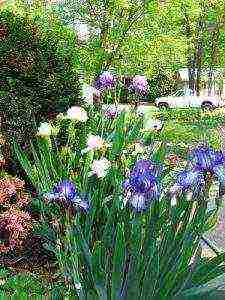 Mid summer. Heat. It seems that in such hot weather, planting or replanting garden plants is not a very useful activity. However, there is a garden dweller who needs exactly the July planting. This extreme is a bearded iris.
Mid summer. Heat. It seems that in such hot weather, planting or replanting garden plants is not a very useful activity. However, there is a garden dweller who needs exactly the July planting. This extreme is a bearded iris.
Of course, it makes no sense to tie the timing of certain agrotechnical measures to a specific date, since much here is directly subject to the weather conditions of a particular region. It is better to focus on the phases of the annual development of irises. Having understood and "feeling the needs" of your green pet, you can get fabulously beautiful gratitude from him in the form of abundant long flowering.
The best time to plant a bearded iris is during the active root growth phase, which begins shortly after the flowering period.But, since the timing of flowering for different groups of irises is different, then the planting time is also shifted.
The earliest - dwarf irises (up to 40 cm) - bloom in the second half of May, followed by the intermedia irises (41-70 cm), and the most spectacular - tall bearded irises (from 70 cm) - bloom in the first half of June and pleasing to the eye until early July. By the way, the last group of irises, in turn, is also divided into early, medium and late flowering varieties. These flowering times are rather arbitrary and can shift depending on the weather.
One to two weeks after the irises have bloomed, you can start dividing the bushes. This procedure can be done until the end of August, however, in the southern regions of Russia, the term can be slightly shifted - until mid-September. A later planting can lead to the fact that the plant will not have time to take root and will not survive the winter, and even if it does, it will be greatly weakened.
Bearded irises are planted only with rhizomes, since their varietal properties are not preserved during seed propagation.
We buy planting material
Delenka (the so-called planting unit of irises) must have at least one formed link of the rhizome, cut to a height of 15 cm, a fan of leaves and in the same way a shortened bunch of roots. First of all, you need to check the condition of the rhizome. It should be elastic, dense, without signs of decay or softening of tissues, the cut should be uniformly light. Slightly below the fan of leaves - small yellowish tubercles should be clearly visible on the rhizome - the rudiments of new roots. If they are already there, then it is difficult to keep them intact due to their fragility, so it will be more difficult for the division to take root. The presence of additional axillary buds on the sides of the rhizome is a guarantee that when the central fan dies, the plant will not die, but will develop lateral fans from these buds. When buying, pay attention to the color of the leaves (especially the central one) - they should be dense, green, not pale. The lateral leaves may be slightly yellowed and dried out, since the cut is always slightly dried after digging. Do not take too thick, large cuttings - they could have been "overfed" with nitrogen in the same place, so such specimens are more prone to diseases and are prone to decay.
It is not at all necessary to immediately plant your new pet in the flowerbed - the bearded iris is not afraid of drying out, on the contrary, it is useful for him. In no case should planting material be stored in cellophane and, in general, in a humid environment.
Irises are not for nothing considered a rather unpretentious crop - they are not demanding on growing conditions. However, when some success factors are observed, the plant can get the most out of it in the form of lush bloom and healthy growth and development.
Choosing a place for planting bearded irises
The best location for growing irises is a sunny area with possible partial shade in the afternoon. In the shade, the flowering of irises leaves much to be desired. In addition, your irisarium should be protected from the gusty wind that sometimes breaks delicate flowers. On the southern slope, bearded irises would be most comfortable and cozy.
We select the soil for planting bearded irises
Most of all, irises do not like damp, heavy, acidic soils. The best option is an alkaline or slightly acidic soil reaction. For problem soils, with a strong desire to have handsome irises on the site, you need to carry out the usual measures on heavy, clay soils, add coarse sand and peat, and on acidic soils, liming. Bearded irises (and this article deals only with them) grow well in slightly rocky areas, on high ridges. Drainage must be carried out under waterlogged lands.
Ideally, the soil for the irisarium should be light, loose, free from weeds.An excess of organic matter is unacceptable, as it causes various diseases. You can add well-rotted manure to the site, seeding it to a depth of 15-20 cm, and ash, coarse sand and even a little gravel can be added to the top layer.
We plant irises correctly
In no case should the iris rhizome be buried when planting, otherwise the plant will need a lot of strength to "push" it to the surface and the plant will not bloom. And in a sadder version - your iris can simply rot and die.
When planting an iris, you need to dig a small hole and pour a small mound of earth in its central part, on which you need to place the rhizome itself, and distribute the roots on the sides. As a result, the rhizome will be almost flush with the ground. The roots laid along the periphery should be sprinkled with soil and slightly compacted, and the upper part, where the rhizome lies, should be sprinkled with coarse sand with a layer of 1-2 cm. Some avid iris growers fully open the "back" of the rhizomes in summer so that they breathe well and warm up in the sun. Watering bearded irises is rarely done when the ground becomes completely dry.
The most successful option for planting irises is the orientation of the rhizome to the south, and the fans of the leaves to the north. With this arrangement, the rhizome is better heated by the sun, which contributes to the active germination of axillary buds and the prevention of diseases.
If you have a small garden and there is not enough space, then it is better to limit yourself to a small number of plants, since irises need space. Better in this case is quality, not quantity. With close planting, as a rule, the least viable plants are oppressed, and these usually include the newest varieties of irises. In addition, overcrowding leads to disease, weakening flowering, rapid leaf closure and confusion of varieties.
The distance between tall species of bearded irises is 50 cm, and dwarf irises are planted at intervals of 30 cm.With appropriate care, irises grow and develop well, and while they mature, the free space in the flowerbed can be filled with small-bulbous and summer plants that do not give self-seeding.
Solving the question of the planting pattern of bearded irises
To correctly make a planting scheme for bearded irises, you need to imagine how they grow. Due to the growth of new annual links of the rhizome, the plant moves forward annually, at the same time it grows to the sides due to the awakening of the axillary buds.
"Chess" (1)
We plant tall irises towards each other, keeping the distance between the two plants at least 50 cm.
"Catch-up" (2)
We arrange irises with fans in one direction, the plants grow, as it were, "in pursuit". The distance with this scheme of planting irises can be less (about 40 cm).
"Round dance" (3)
With this arrangement of irises, an even smaller distance between plants is required (about 30 cm), but they must be planted a considerable distance from the edge of the flower bed, otherwise after a few years your irises will simply "slide" from it.
To get a complete image, just click on the desired image.
Irises, planted in small groups in correctly selected color combinations, as well as solitary plantings, look great. With proper care, a single growing bush of tall, bearded iris can grow into an entire flower bed in a short period of time. The most realistic option to grow such beauty is to choose varieties that are zoned to the conditions of your area and have long proven themselves in the world market of varieties.
I would like to repeat once again that this article is only about bearded irises, the conditions for growing Siberian and Japanese irises are somewhat different, there will be separate topics about them.
The word "iris" is translated from Greek as "rainbow". This is the name given to perennial beautifully flowering plants for the variety of shades.In the people they are affectionately called "cockerels" or "iris" because of the shape of the leaves. They resemble a scythe. And also because of the shape of the flowers, which are similar to the beard and comb of a rooster.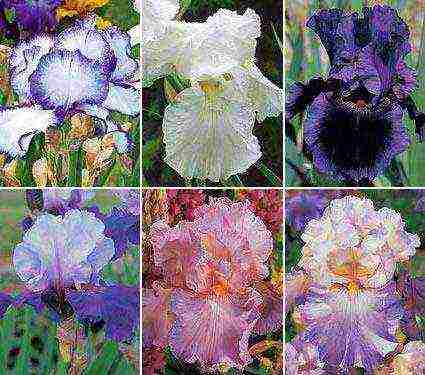
In addition to their beautiful appearance, irises have medicinal properties. Today, there are about three hundred varieties of these magnificent flowers. But the most popular among gardeners are German irises. They are widespread in our country as well. The type species of the genus is Germanic iris. The varieties grown today in summer cottages can be called hybrids (Iris hybrida hort). Today there are about 35 thousand of them.
German iris
This variety is extremely rare in natural conditions. It was first described in the 19th century in Germany. Later, Z.T. Artyushenko on the territory of Ukraine: in the Transcarpathian region, in the vicinity of the city of Vinogradovo. Iris Germanic purple has broadly xiphoid glaucous leaves. Their length reaches 50 centimeters, width - 30 mm. The peduncle of the culture is branched. Can be as long as leaves or longer. The flowers are large, painted in bluish-lilac or purple. They have a pleasant strong aroma, light blue or yellowish beard. The capsule is slightly elongated, oval in shape. Seeds are small, wrinkled.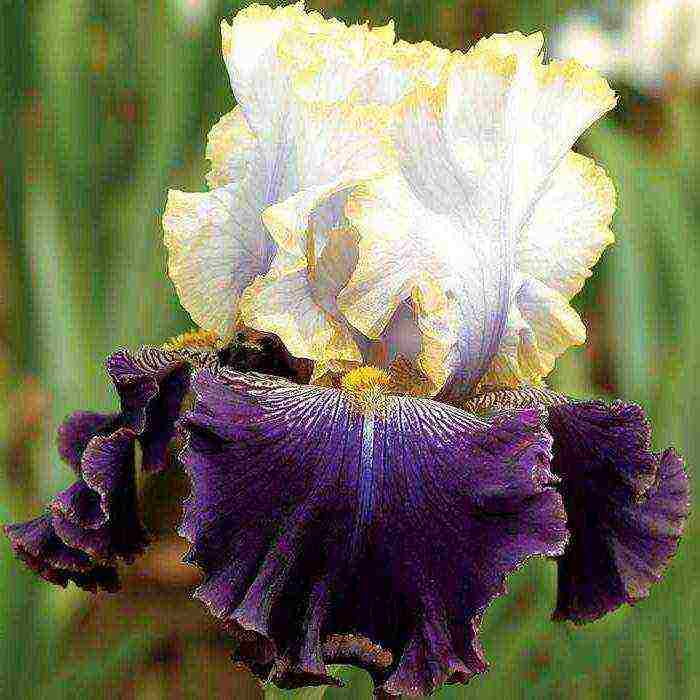
Bearded irises: description
The numerous group of varieties and species of bearded irises belongs to a separate complex and interesting group. Their rhizome has clearly visible annual thickenings - links. They can be quite thick and completely naked. Germanic bearded irises are distinguished by large brightly colored flowers. They have numerous hairs on the perianth of the beard.
Iris Germanic: varieties
These are moisture-loving, frost-resistant flowers that do not require complex care. They are very popular with gardeners all over the world. Refined and elegant irises can decorate any area. They look great in flower beds and natural landscapes, they grow quite quickly. The advantages of irises are as follows:
- Reasonable price of bulbs.
- Uncomplicated agricultural technology.
- Original appearance.
- Compatibility with other garden plants.
Sultan's Palace
This Germanic iris is considered one of the most spectacular in its family. The delightful flower has bloody-scarlet upper petals, collected in a graceful dome, and dark red, with a burgundy, almost black, edging around the edge. The beard has a rich yellow tint.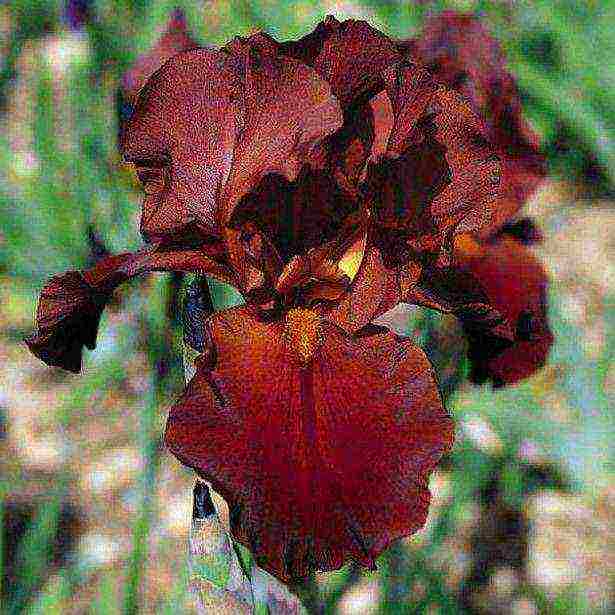
The graceful shape of the Sultan's Palace iris, as well as its exquisite delicate aroma, delight gardeners. This species blooms in May for two to three weeks. Magnificent deep red buds bloom on a powerful stem. Its height reaches 60 cm. This type is often used to decorate flower beds.
English Cottage
And in the next photo you can see another German iris. It was created with German pedantry in the style of English classics. The flawless set of lines of this perfection has formed a truly luxurious bud. Dazzling snow-white large flowers cover lavender veins at the base of the petal with bright yellow tongues of dense villi (in the center). The diameter of this miracle at full disclosure reaches fifteen centimeters. The stems are flexible and strong. They can grow up to one meter in length. Leaves are light green, collected in a fan-shaped bunch. Flowering begins in May. It is during this period that the entire garden is filled with a delicious aroma.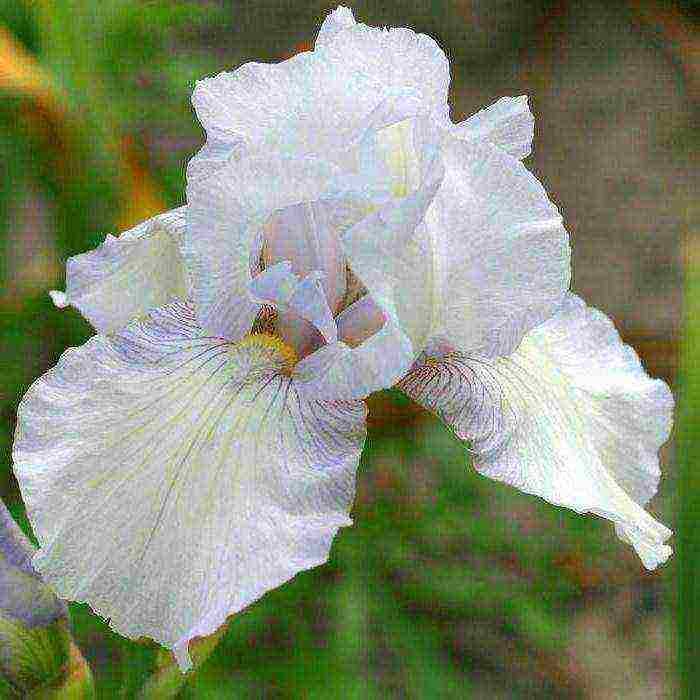
Another important advantage of this plant is that Iris Germanic English Cottage belongs to remontant plants. Its magnificent bloom can also be enjoyed at the end of the summer season.
Crinoline
And this is probably the tallest German iris. An unusually beautiful herbaceous perennial can grow up to 120 cm in your garden. Its leaves are xiphoid, covered with a light waxy bloom. They are collected in fan-shaped beams.It is noteworthy that the flowers remain decorative throughout the summer. They appear on a branched, sturdy stem. The buds are colored dark burgundy with a white spot on the lower petals. The bright yellow beard is covered with thick hairs. This iris is very stable in cutting. He needs minimal care (we will talk about this a little later). The plant prefers well-lit areas, protected from wind and moisture stagnation.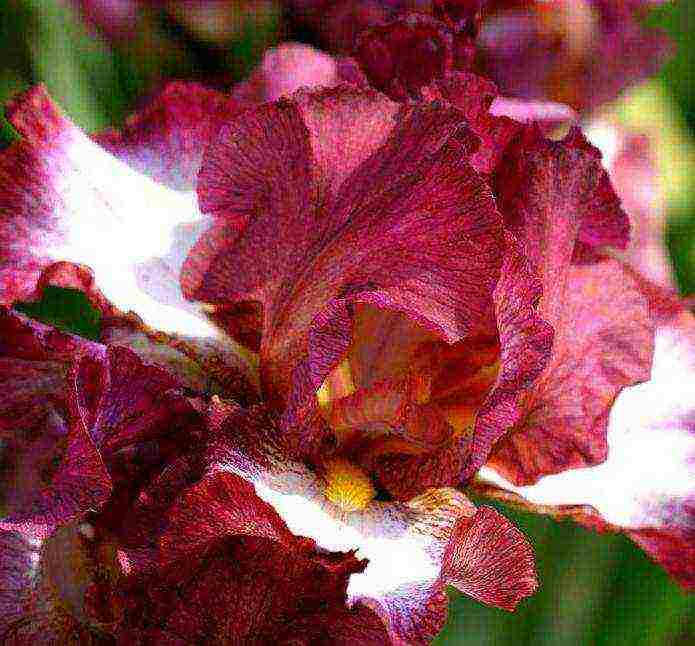
Iris Germanic: planting and care
If you want to breed this crop, the first step is to choose a planting site. This should be a well-lit area in the morning. Most of all, a slope or a hill is suitable, which allows melt water to drain freely. Iris Germanicus, which is not difficult to plant, likes good drainage. In addition, all varieties of this crop require nutrient-rich soil. Therefore, if it does not meet such requirements on the site, it must be fertilized.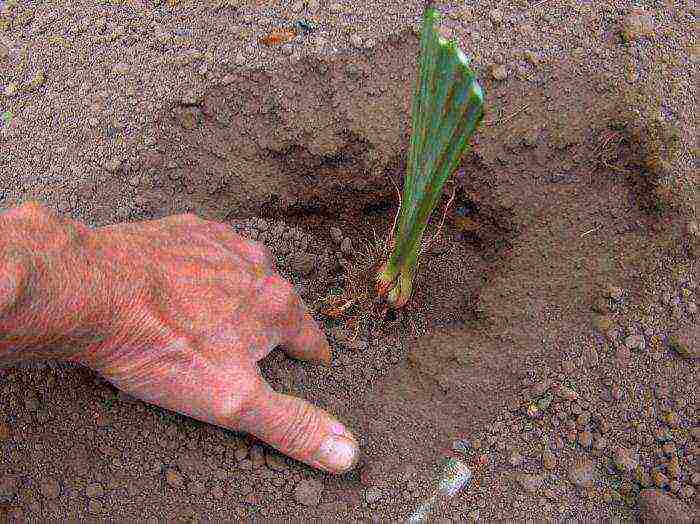
Before planting (in spring), add compost or oily garden soil to the soil, feed it with potassium-phosphorus fertilizers. If the acidity of the soil is increased, it is necessary to add wood ash or dolomite flour to it. Loamy soils require dilution with peat and sand, while sandy soils require clay. To disinfect the soil before planting, treat it with fungicide and herbicides. And one more important detail: when planting German iris, do not fertilize the soil with manure.
We process the planting material
In spring, the planting material needs to be treated with growth stimulants ("Zircon", "Eco-gel"). It is also necessary to shorten roots that are too long using a sharp garden knife. The same applies to rotten areas. The roots should be disinfected. To do this, it is enough to hold them for about twenty minutes in a weak solution of potassium permanganate.
Landing in the ground
To plant iris in open ground, you need to make a small hole. In the center, you need to pour a mound of sand, on which the rhizomes are carefully laid out in a horizontal position. After that, they must be straightened and covered with soil so that the upper sections remain above the ground. Now the plant needs to be watered well. If you bury the rhizome completely, it can rot. The distance between plants must be at least fifty centimeters.
Iris care
Many summer residents and experienced flower growers breed German iris on their plots. Planting and caring for it is pretty straightforward. Therefore, observing simple rules, a beginner can also cope with this work. The main feature of this culture is the love of warmth and light. If you have well prepared the site for planting, then the irises will have enough nutrients embedded in the ground. If the soil is depleted, during the growth stage, you can feed the plant with phosphorus-potassium compounds, which are applied at the root. This is not recommended during flowering.
Some more tips
Irises are in dire need of abundant irrigation, especially during the budding period. At this time, it is recommended to water them as soon as the soil at the roots dries up. Weeding is also very important for these plants. Their root system is close to the surface. Therefore, in order not to injure her, the weeds should be harvested by hand. In addition, it is necessary to loosen the soil two to three times per season.
After the flowering of the bud, you need to cut off the peduncles (if you are not going to plant the plant). Trim the yellowed leaves, making them semicircular. When the foliage is completely dry, remove it. In late autumn (before frost), sprinkle the bare roots with soil and cover the area with sand or peat about ten centimeters. In very cold winters, the plant is covered with spruce branches or dry leaves.
